于德水
1953年生 山西阳城人 现居郑州
1978年从事摄影
1983年中央工艺美术学院进修摄影专业
1985年加入中国摄影家协会
2001年任河南省摄影家协会主席
2002年任中国摄影家协会理事
2008年任中国摄影著作权协会理事
2008年任河南理工大学兼职教授
2014年任中国摄影家协会纪实摄影委员会委员
2014年任世界华人摄影联盟副主席
获奖
1994年获中国新闻摄影奖(非突发新闻类)金奖
1995年获中国新闻摄影奖(非突发新闻类)金奖
1996年获中国摄影金像奖(提名)奖
2001年获中国摄影家协会“德艺双馨”荣誉称号
2004年获中国摄影金路奖
2004年获中国摄影传媒年度人物大奖
2005年获河南省优秀文化成果奖(一等奖)
2006年获中国摄影家协会“突出贡献摄影工作者”称号
2008年获“文明中国杰出摄影家”称号
2010年获“文明经典·杰出摄影家”称号
2011年获“丽水国际摄影节”大奖
2012年获“中国摄影金像奖”
展览
2014年“黄河流年”参加巴黎fotofever(法国)
2014年“原本”参加济南国际双年展
2014年“2014·雪”参加北京国际摄影周
2013年“大地耕诗”作品收藏展(萃文轩)
2012年“生命河流”展览(西双版纳)
2012年“黄河流年”展览(武当山)
2011年“黄河流年”参加洛杉矶POHTO LA ( 美国 )
2010年“中原纪事”参加纽约AIPID ( 美国 )
2008年“黄河流年”参加中国当代艺术展(西班牙·马德里)
2008年“河风”展览参加休斯敦摄影节(美国)
2007年“大地耕诗”展览参加亚特兰大摄影艺术节(美国)
2007年“黄河流年”参加广东美术馆双年展
2007年“黄河流年”参加广东美术馆双年展
2006年“中原土”参加“往事如歌”五十年20人联展(成都)
2005年“中原纪事”展览 (丽水)
2004年“黄河流年”展览(武夷山)
2003年“千橲之爱”两岸摄影家联展(台北)
1998年“正月纪事”展览(郑州)
1996年“感受西部”展览(郑州)
1995年“摄影·中原”联展(郑州)
1983年“黑白摄影联展”(北京)
出版
2014年出版《原本》摄影作品集
2013年出版《大地耕诗》摄影作品集
2009年出版《流逝的黄河》摄影作品集
2007年出版《大地耕诗》中国摄影家系列专集
2005年出版《于德水摄影作品集》
2005年主编《河南摄影五十年》
2003年出版《黄河流年》摄影作品集
2003年主编《河南摄影百家》
1994年出版《中原土》摄影作品集
收藏
2008年《黄河流年》为西班牙当代艺术博物馆收藏
2008年《跑秋》为广东美术馆收藏
2007年《黄河流年》之十七为中国摄影博物馆(丽水)收藏
2005年《黄河流年》为河南博物院收藏
2004年《中原纪事》为广东美术馆收藏
Yu Deshui
1953 born in Yangcheng,Shanxi
Current lives in Zhengzhou, Henan
1978 Engaged in professional photography
1983 Studied at Central Academy of Arts and Crafts, Photography
1985 Joined China Photographers' Association
2001 Director of Photographers' Association of Henan province
2002 Director of China Photographers' Association
2008 Chairman of Chinese Photography Copyright Association
2008 Professor, Henan Polytechnic University
2014 Documentary Photography Committee Member of China
Photographers' Association
2014 Vice President of World Chinese Alliance of Photography
Awards
1994 China News Photography (Non-Breaking News Class) Gold Prize
1995 China News Photography (Non-Breaking News Class) Gold Prize
1996 Honor Prize of China Photography Awards (Nominated)
2001 Honor of China Photographers' Association
2004 China Photography Golden Prize
2004 China Photography Media Figure Of The Year
2005 Excellent Cultural Achievement (First)
2006 Honor of “Outstanding Contribution Photography Worker” of China
Photographers' Association Henan Committee
2008 Title of“Outstanding Chinese Civilization Photographer”
2010 Title of “Civilization and Classic Outstanding Photographer”
2011 “Lishui International Photography Festival” Award
2012 “China Photography Awards”
2007 “The Farming Poetry” China Photographer Work Series
2005 “Photography of Yu Deshui”
2005 “Fifty Years of Henan Photography”
2003 “Past Time of the Yellow River”
2003 “100 Photographers of Henan”
1994 “The Central Plains Earth”
Collections
2008 “Passing Time of the Yellow River”, Spain Museum of Contemporary
Art
2008 “Running Autumn”, Guangdong Museum of Art
2007 “Passing Time of the Yellow River, No. 17”, Lishui Photography
Museum
2005 “Passing Time of the Yellow River”, Henan Art Museum
2004 “Central China Chronicle”, Guangdong Museum of Art
Exhibitions
2014 “Passing Time of the Yellow River”, Paris Fotofever, France
2014 “Origin”, Jinan International Biennale
2014 “2014 · Snow”, Beijing International Photography Weeks
2013 “Poem Of The Earth”
2012 “River of life”
2012 “Passing Time of the Yellow River”, Wudangshan, China
2011 “Passing Time of the Yellow River”, POHTO LA, USA
2010 “Central China Chronicle”, AIPID, USA
2008 “Passing Time of the Yellow River”, China's contemporary art,Madrid, Spain
2008 “River Wind” Houston Photography Festival, USA
2007 “Poem Of The Earth”, Atlanta Photography Festival (USA)
2007 “Passing Time of the Yellow River”, Guangdong Museum of Art Biennale
2006 “The Past Songs” Fifty Years 20 Photographers Exhibition (chengdu)
2005 “Central China Chronicle”,Lishui
2004 “Passing Time of the Yellow River”, Wuyishan, China
2003 “Love of ” Taipei and Mainland China Photographers
Exhibition,Taiwan
1998 “The Chronicle of Day” (zhengzhou)
1996 “Experience the West” (zhengzhou)
1995 “Photography, The Central Plains” Exhibition
1983 “Black And White Photography Exhibition”, Beijing
Publications
2014 “Origin”
2013 “Poem Of The Earth”
2009 “The Passage of the Yellow River”
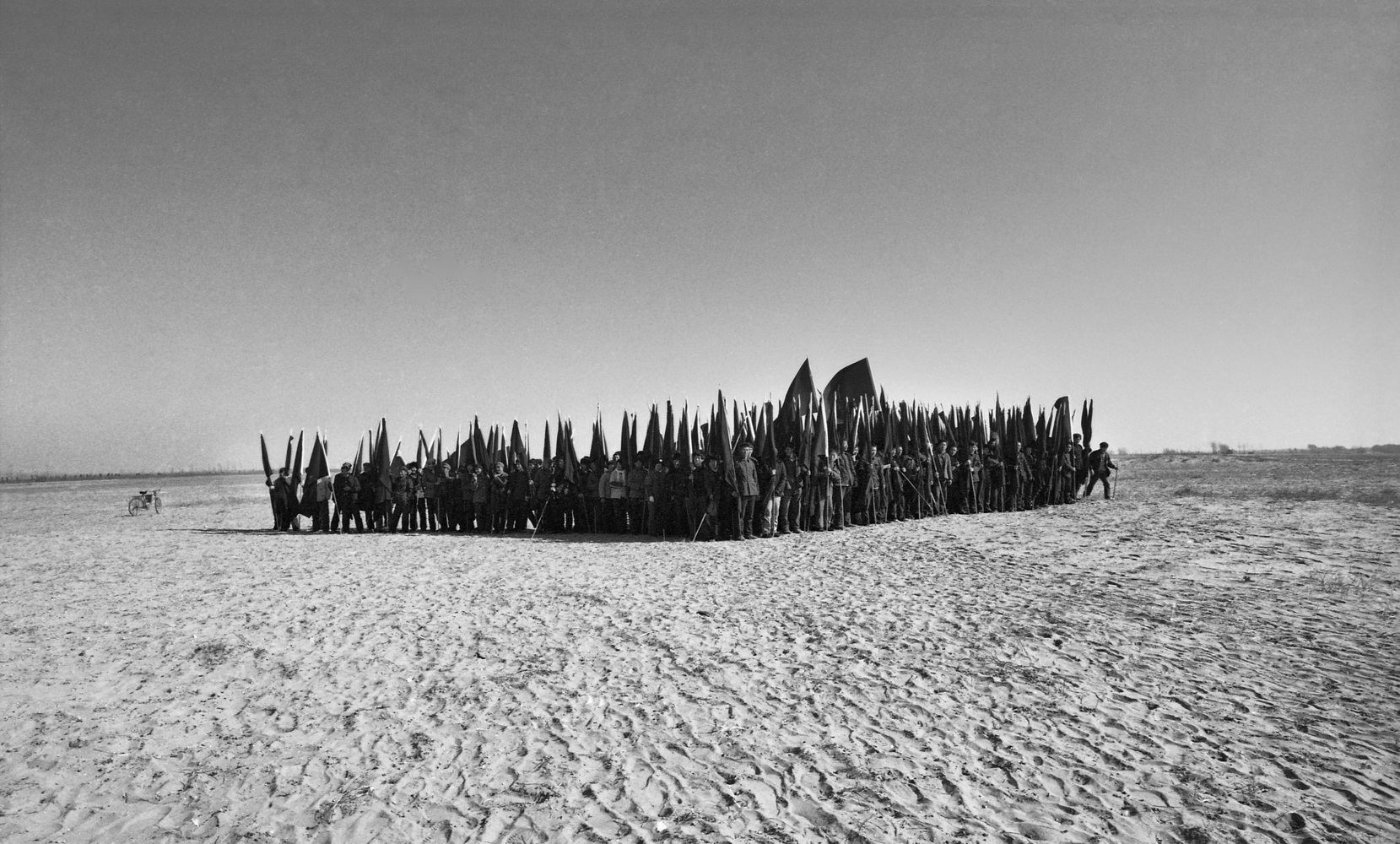
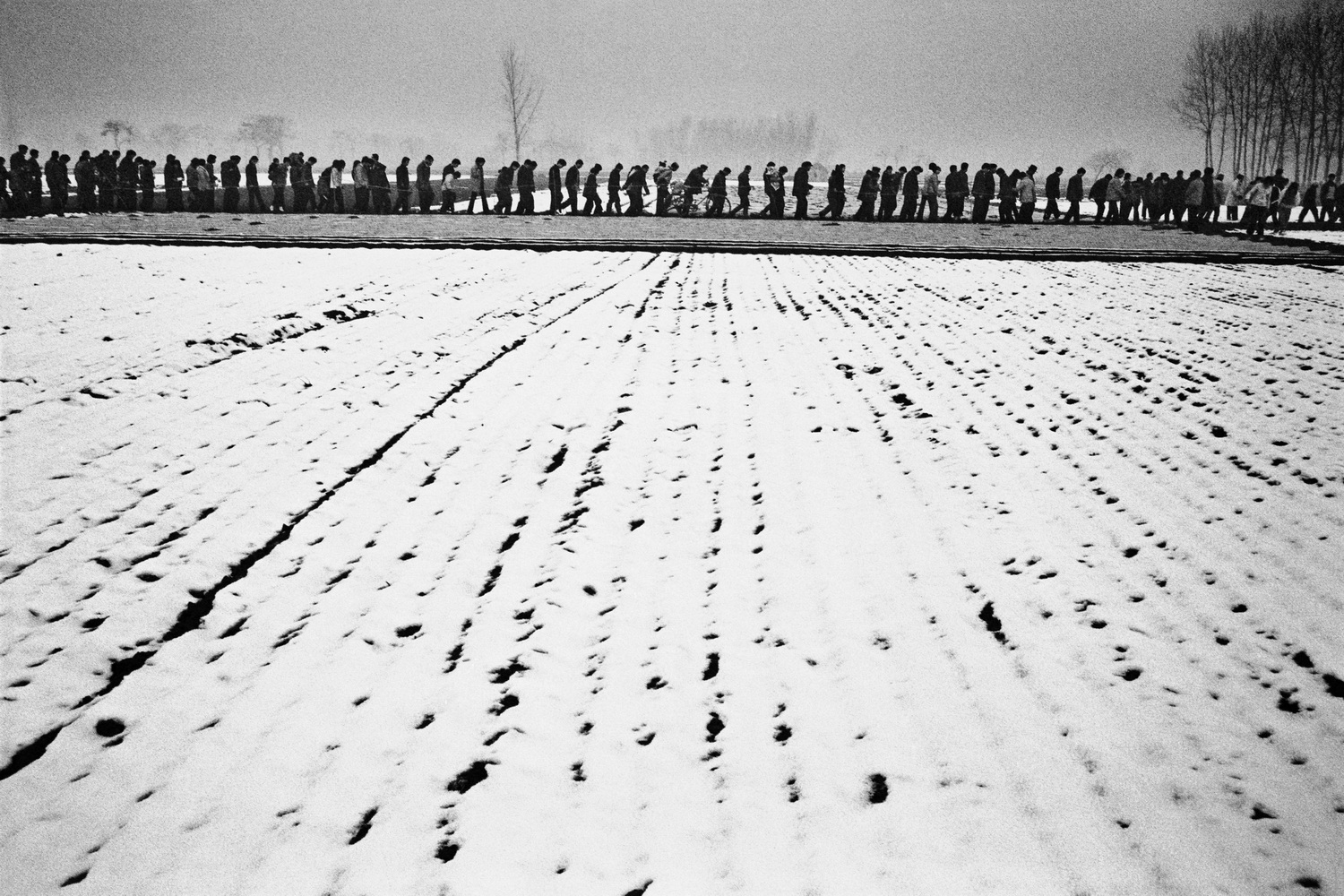
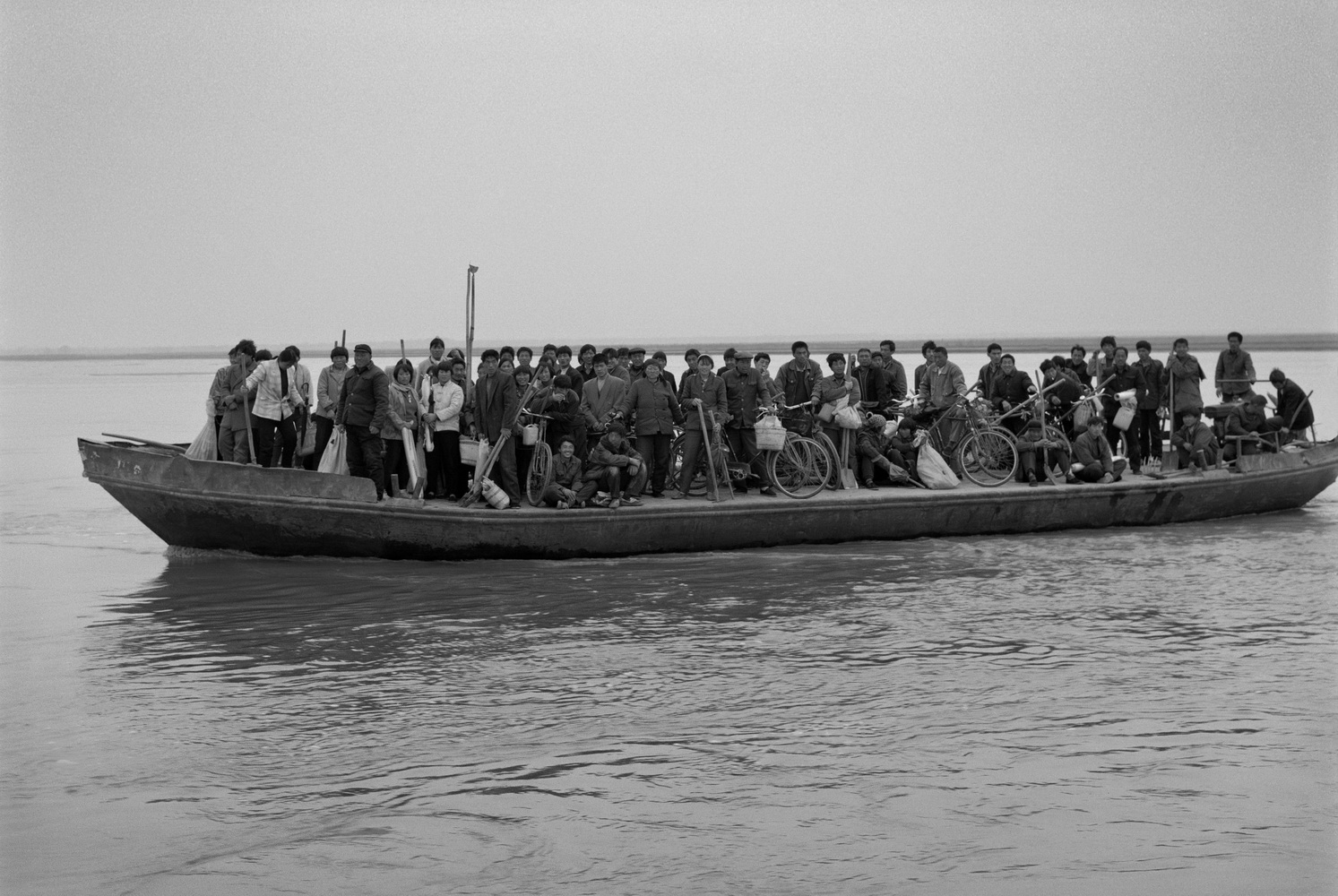
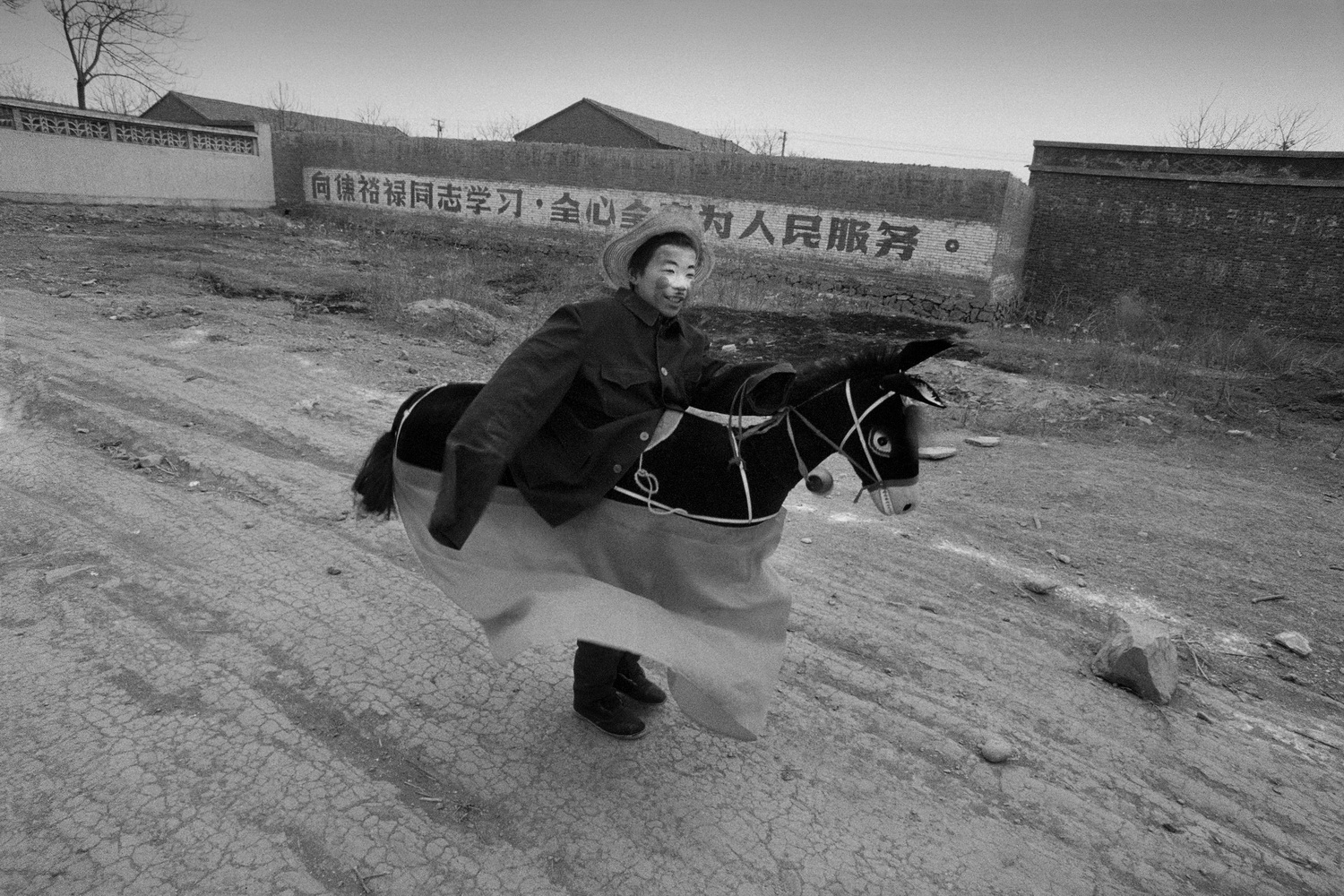
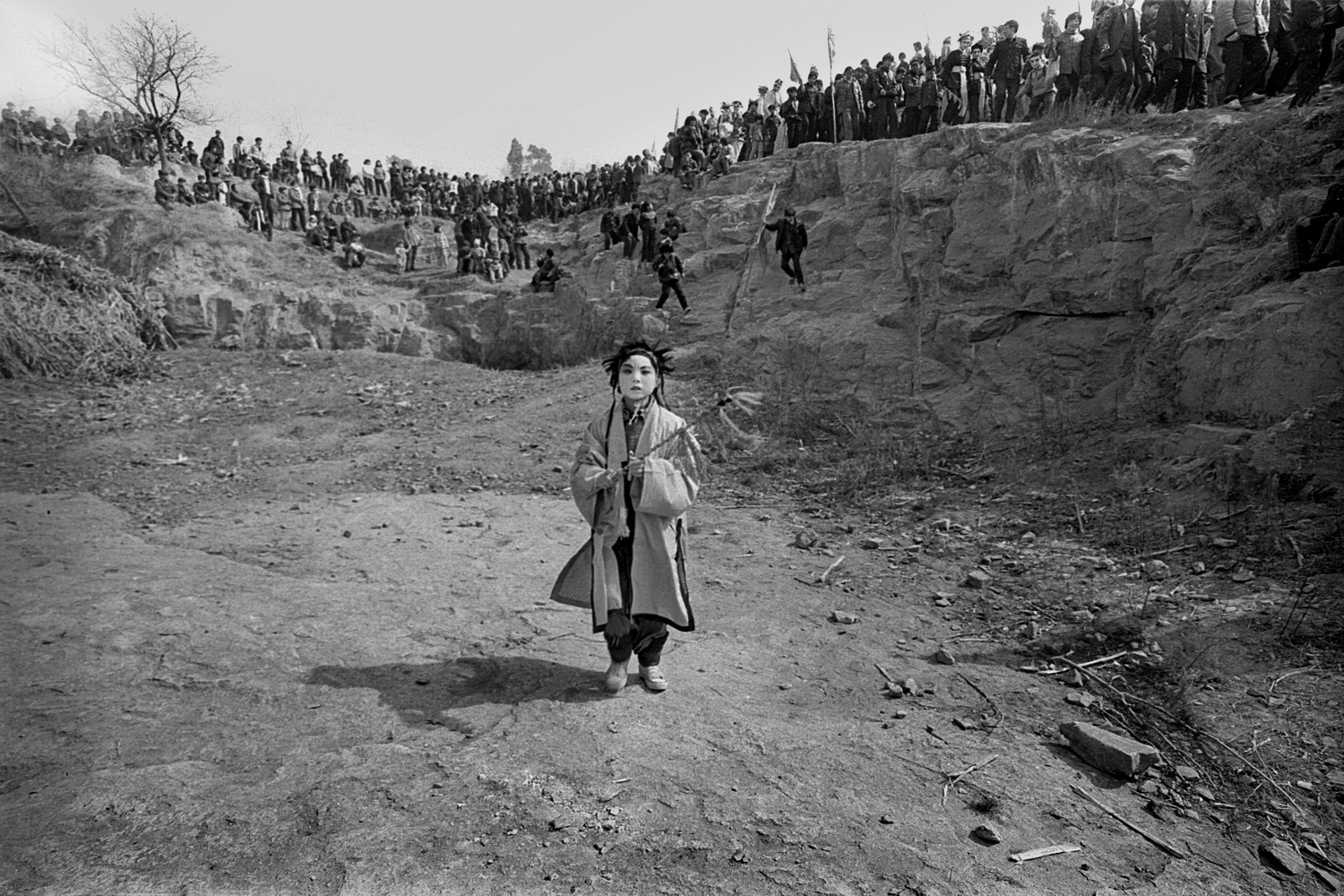
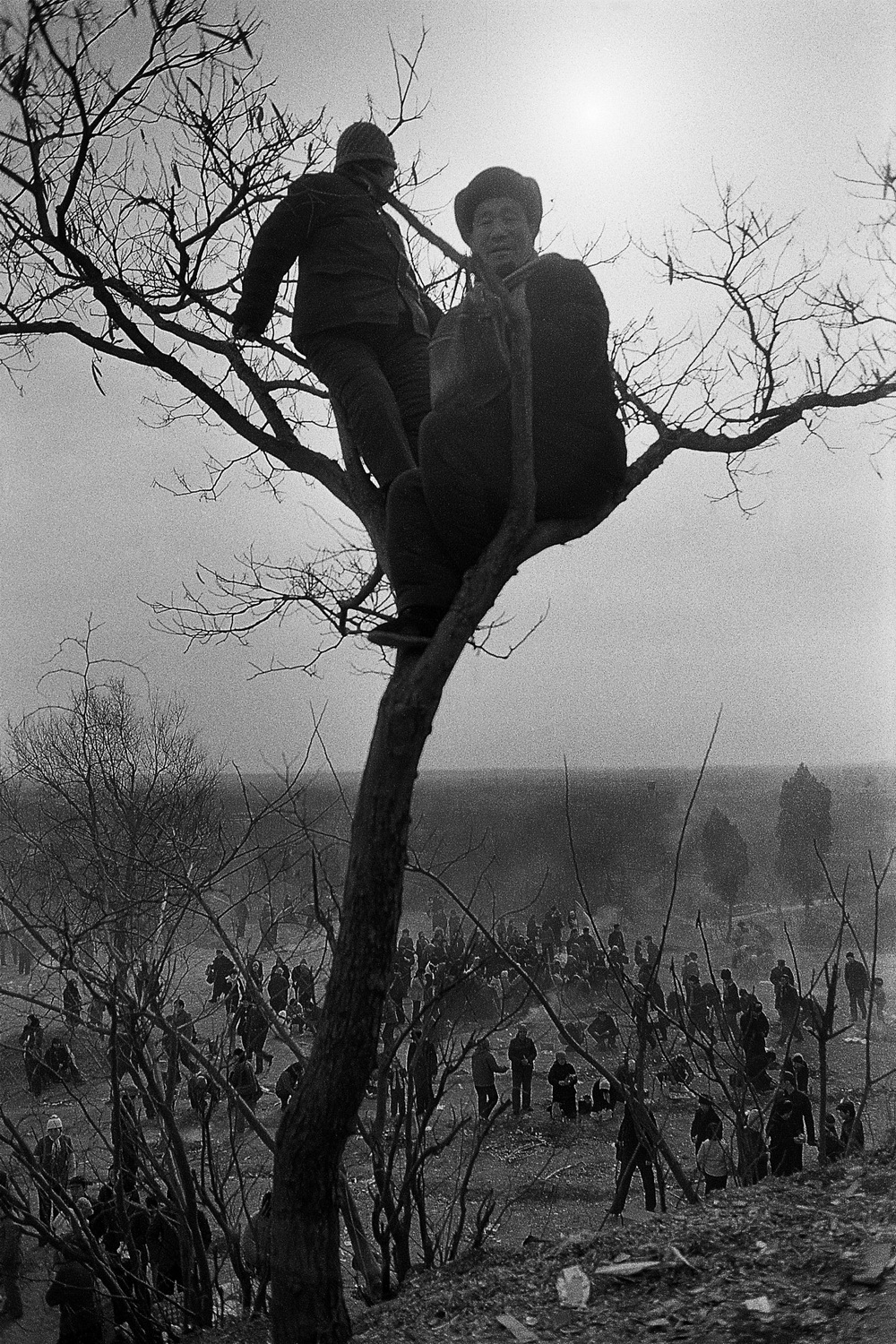
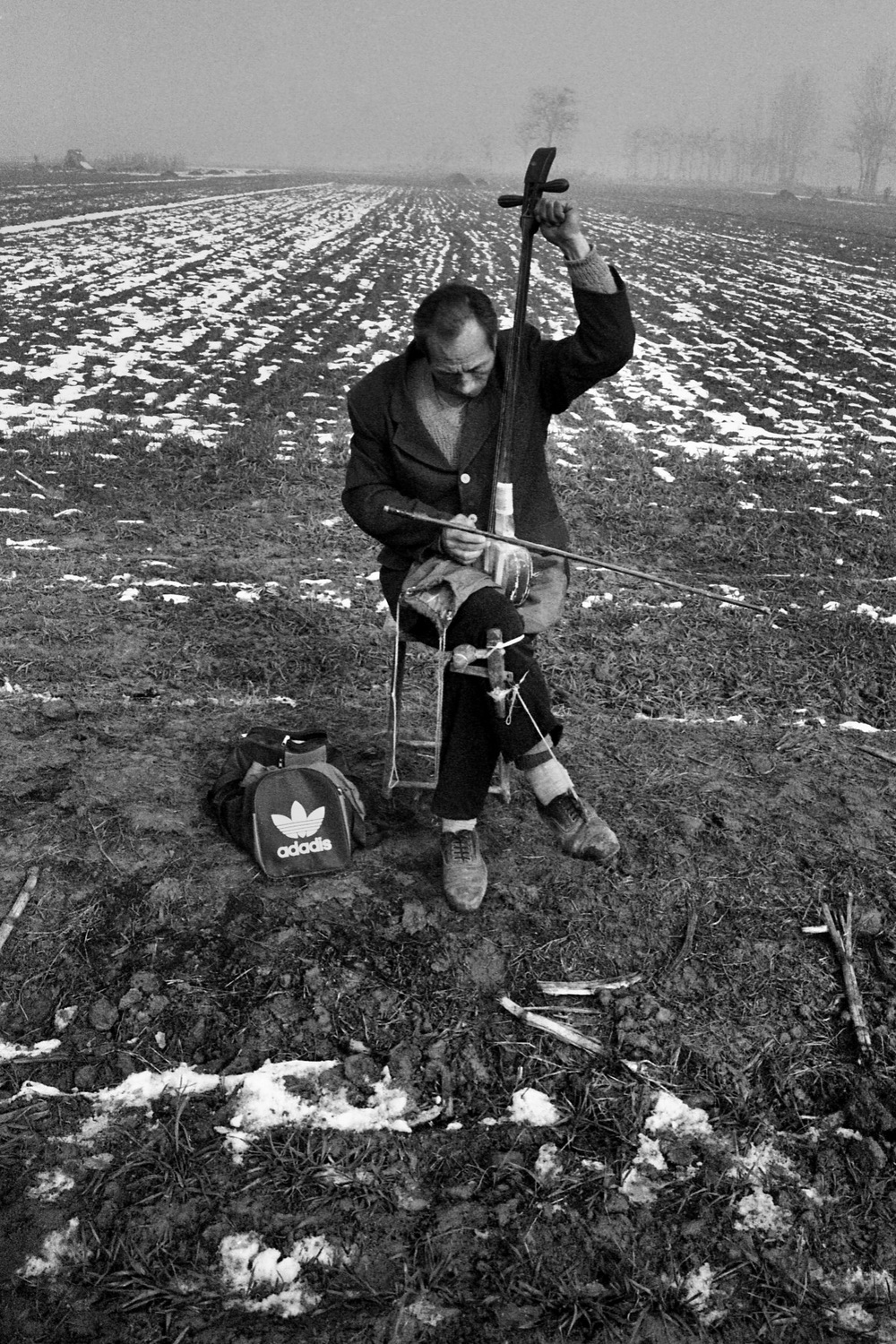
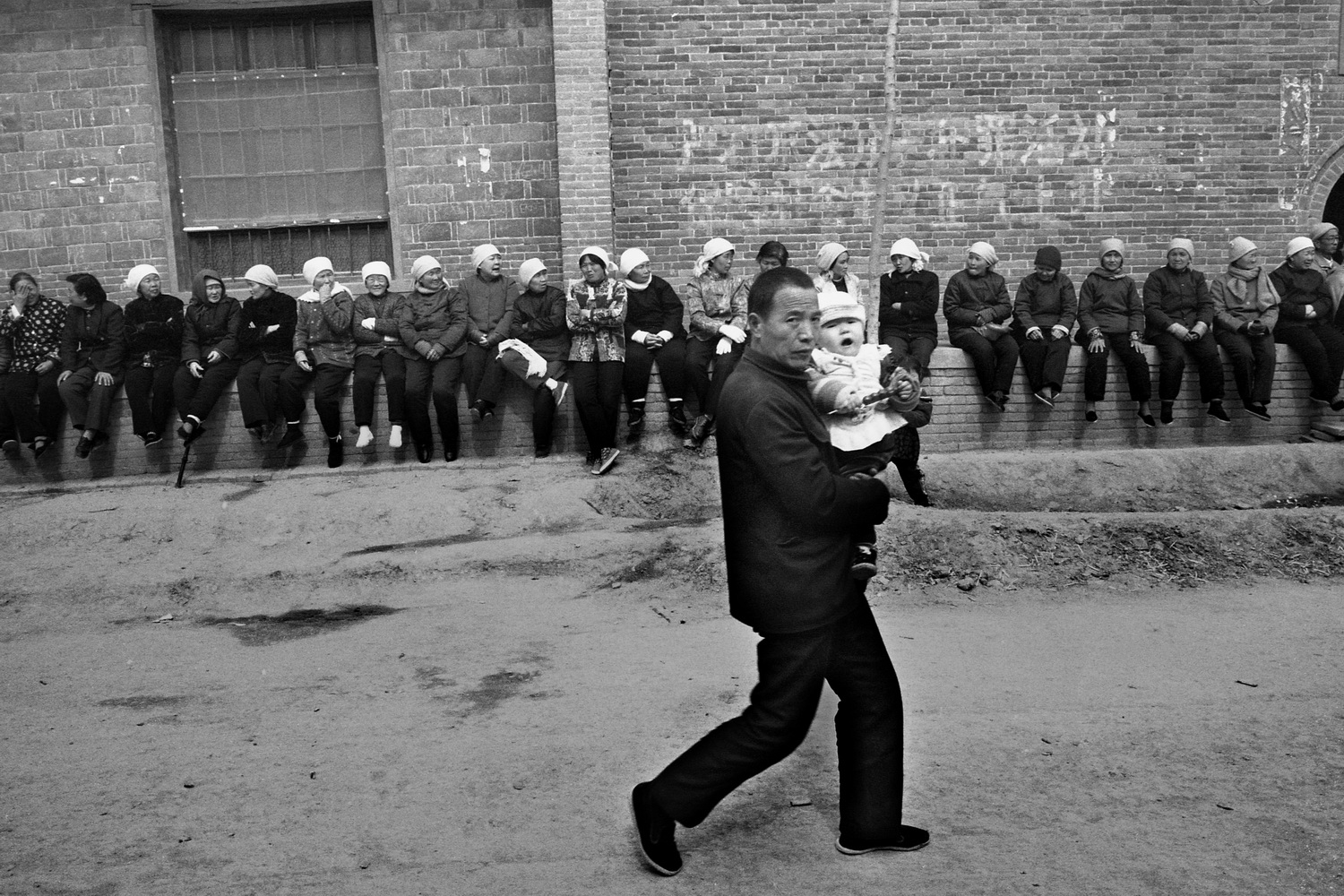
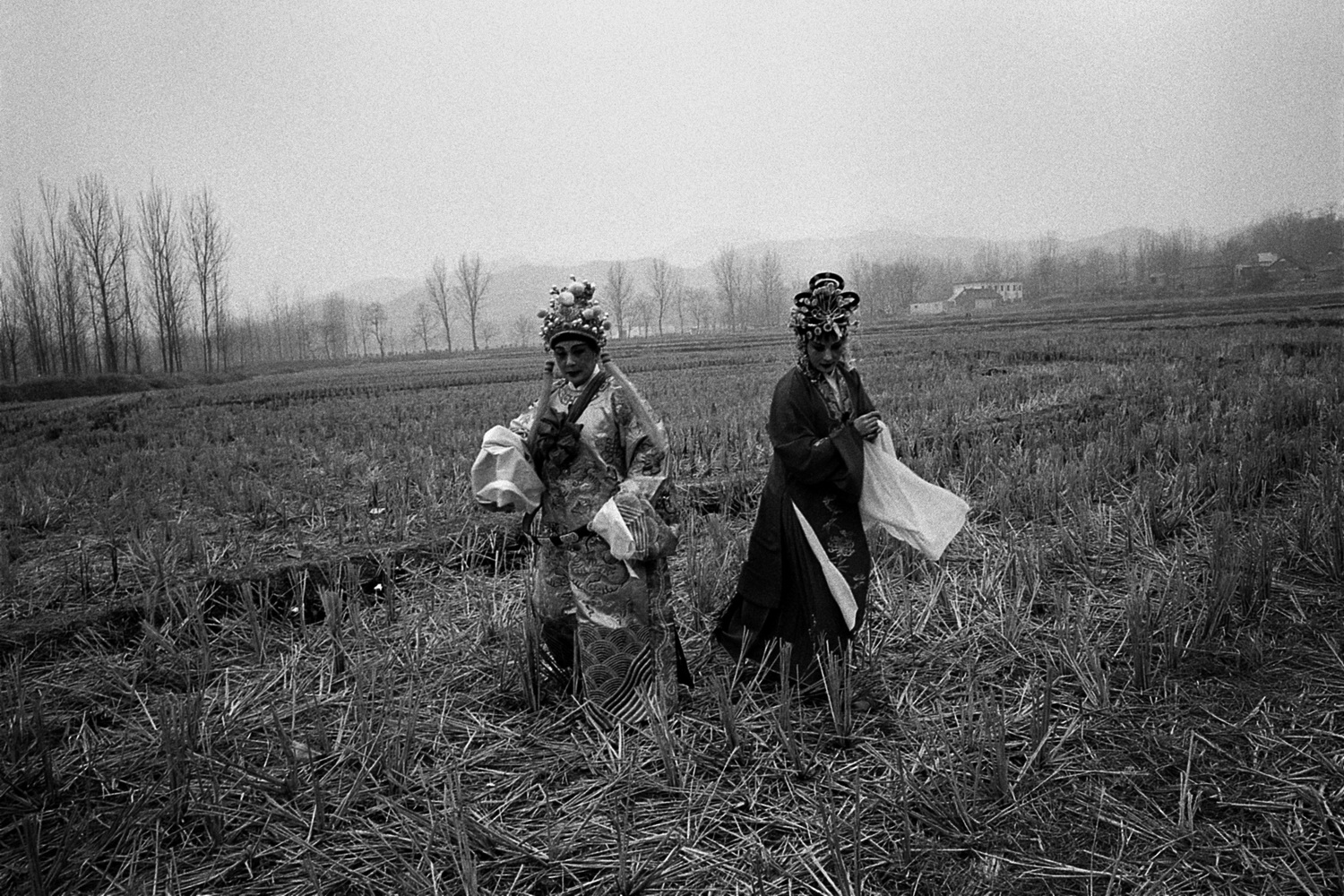

影像,流年似水
中原厚土
李江树
麦穗在晚霭中摇曳并发出喑哑的赤金色。远处染着青黛色的岗地、丘陵逶迤盘曲。于德水又一次在高旗营儿、杜官滩、小姚庄儿昏暗的簇簇林阴间和阡陌纵横的乡道上趱行。向晚的风吹拂着他。他在回旋于耳的风中,听到了麦粒坐仁儿发出的沙啦啦的声响。静谧中,他浑身觉出一种与万物亲合并透彻肌肤的快感。他举目向左前方环视,他的心头忽然感受着远山的忧郁与黄河东岸巨大、宽广但却是模糊的风景感。在沉思的内省中,脚下踩着的无论是颓败的乡土还是生机勃勃的乡土,在他心中都会有一种内敛的聚合力。他在人群中寻找着属于他的颗粒。而他所有的作品终将在个性与智性的统一中,成为他记忆的复制品。故土、母语、人生场景,富于历史意识的形象图式,作为摄影家,他的眼睛不仅估量着色彩、光线、形态、距离,还测度着生命在这其中的轻重与生命的丰富性。在拍照的当儿不可能与对象交流思想,但他却与他们达成了某种默契。他没有努力使自己的思绪去试配事物,而事物却顺应着他的思绪。摄影使他在对自身的不断发现中,终成为对图像的发现。
他的拍摄着重于民间生活的日常性和民间生活的价值系统。他的画面充满着丰赡的人性。他从身后拍那些穿着老黑棉袄,满满地抱了一大捧麦秸的老汉;那老汉背后鼓荡着一股我们抵挡不住的情感。他拍大出殡,黄土高原上的坡坂、塬谷、梁峁、丘阜,把生于斯长于斯还于斯的农民深深地压进了黄土的洼凹。他拍民工——中国农村有两亿剩余劳动力,680万外出讨生的民工,他镜中突出的是背着抱着的大包袱和满脸的焦灼——民工生活在都市的边缘,在城市受着歧视性的管理。他们居无定所。他们弃田撂荒,外出讨生。他们的背景是凋敝的乡村。“黄鹂唱歌,麦子要割。”于德水拍赶场的、候鸟般出没的麦客。这些背着蒸晒的太阳,为雇主下苦力的穷杠子,啃干馍、喝面汤、睡草棚。于德水拍苍寂寥廓的黄河故道上的《旗手》,这是一帧极具象征意义的民族寓言:浩大的风,贫瘠的黄土上腾起黄沙,空茫的历史在旗幡上哗啦啦飘动——他的照片中没有惊悸、躁动、惨烈、暴力,他从来不在照片中制造视觉惶恐。艺术中的“高蹈”在他中后期的作品中也是找不到的。真正撼动人的是生活本身。他像孙犁的《铁木前传》一样,平静地向你贡献着一个普通的乡村故事。一个农民寒伧、困顿的、忧戚、沐雨栉风的生活比道德谱系中善与恶、美与丑的思辩更能净化人。
于德水对农民的生活有种天然的认定。即便农民中需要进行“国民性改造”的那一部分,他也认为他们自有他们的道理。扑拙的乡风陶铸着具有扑拙乡风的摄影。
于德水的作品还有种凝重性。在静止的动感中,鲜活的生命成了生命的化石。那一刻,就在那一刻,容涵的东西很多:勤勉、耐劳,必得汗流满面方能糊口为生的生存意识。
从浑朴的民风中延拓出民族、历史、地理的空间。人有自我实现梦幻的能力。所有的拍摄机会也会不期而至。在自己的这一方热土,不会有旅游者在高山大河前找到了差异的那一种兴奋。描摹自己熟悉的人物,熟悉的行为,熟悉的场景,用不着镂金错彩。在平和的拍摄中洇出几个“点”,由这几个点放散开去,从而引导观者思考某一种生存。
平和安静的视点是于德水的基本视点。事实上,最本质的生活便是这种平和安静的生活。平和安静不等于闲适、闲静、闲寂,深度与意义也不会因平和安静而被削平和耗散。于德水用相机对劳瘁的生存,困顿的生命做一种具本体论意味的精神探索,并表达出自己的故土之哀、之怜、之情、之爱。他没有发出宏大的宣言,也没有为观者制作出“高峰体验”;他只是凭着一股韧劲儿,执着而不动声色地在“小事件”中还原着生活的原貌。一种抒情的情愫撩拨着观者,历史的陈述在平静的宣叙中展开。中原厚土,大地耕诗,黄河玉成了于德水。于德水也以自己的方式为自己挣到了一份黄河人的光荣。
每一个人的内心都是一个多层次的立体系统。较之同龄人,于德水早早就没有了作为一个名人的那份虚荣。但他距一个战士,一个思想者,一个为第三世界和底层人民吁请呼号的斗士还相去甚远。他还仅只限于“独善”,仅只限于坚持个人生活中的操守。平静的韧性与耐性是他性格中的特质。他的思想不是沿着史诗的传统,而是沿着内倾的个人体验的传统。摄影是他精神中最重要的内容。摄影不仅是他精神上的一个分支,而且是构成他生命的材料。
Grain sways in the freezing wind, and shares the golden red hue with the sunset glow; paints the low mountains and winding hills far in the distance. Once again, Yu Deshui walked alone on the path across Gaoqi Alley, Duguan Tan, and Xiaoyao Village. The wind touched his face, and he heard the ears of grain whispering in the wind. At the tranquil moment, he enjoyed that being so close to the nature. Looked around, he deeply felt from the heart of mountains’ blueness and the Yellow River’s power but all are kind of vague. In his thoughtful mind, he is looking for something belongs to himself. Thus, all the photographic works grow from the homeland, mother tongue, and personal experience in his memories. At the shooting moment, they cannot communicate with each other, but come to a spiritual agreement. He never tries to compromise to every subject he’s dealing with, but subjects appear to follow his mind. His photography develops with the process of understanding himself.
His photographs focus on daily life and folk value of local people. Those images inquire the humanity. People in his photographs include old men wearing ragged cotton-padded jacket or carrying bundles of wheat, there’s always an emotional context behind the figures. He takes photos on local funerals, and also records local landscapes of the Loess Plateau. He had a series of photographic works on rural laborers – a native special group of people in China. There is 6.8 million of population from rural country that live in urban big cities in Beijing, Shanghai, and Guangzhou. Most of them have no stable places to live in and suffer discrimination from urban residents. They give up farming life, and make a living as working as a laborer in cities. Their background is the farmland. Yu Deshui pays attention to the unique group of people and create photographs about their life and status. In his work “Flag-bearer”, he creates a fable about the nation: sand of the barren yellow plateau raises by the wind, history seems waving like the flag. In his photos, you will never see horror, agitation, tragic, violence, he never intends to create any uncomfortable.
He also tells stories in his pictures, he believes that most moving thing is life itself. He tells you that the story of hardship of a farmer purifies the soul than what's written in books do.
Yu Deshui has a natural acquaintance of farming life. His work somehow has a kind of stateliness. In the lively images, a live turn into a fossil.
Flat and quiet are the most noticeable character in Yu Deshui’s photos. In face, he said, the essence of life, it's about the flatness and quietness.
Flat and quiet not equal to idle, leisure, or alone, it has a much deeper meaning. Yu Deshui lives with his camera, makes an exploration of human spirits. He doesn’t have laudable aims or announcement, and doesn’t create a “peak experience” for audiences. However, he sets out to be dedicated to restoring the nature of small events, and makes a statement for history. People in the Central China have a common native complex of ‘Thick Soil’ on this land, Yu Deshui believe that it’s an honor to be one of them. People and the land support, help, and nurture each other.
Every individual has his or her own systems. Compared to peers, Yu Deshui stays out of stubbornness and pride as a famous person. There is still a distance to a real fighter, a thinker, and a warrior who gives a voice for the grass-root class and people from the-third-world. However, calm endurance and patience is good qualities in his personality. Photography contains all these good qualities of Yu Deshui, and becomes one of the most vital things in his life.
1953年生 山西阳城人 现居郑州
1978年从事摄影
1983年中央工艺美术学院进修摄影专业
1985年加入中国摄影家协会
2001年任河南省摄影家协会主席
2002年任中国摄影家协会理事
2008年任中国摄影著作权协会理事
2008年任河南理工大学兼职教授
2014年任中国摄影家协会纪实摄影委员会委员
2014年任世界华人摄影联盟副主席
获奖
1994年获中国新闻摄影奖(非突发新闻类)金奖
1995年获中国新闻摄影奖(非突发新闻类)金奖
1996年获中国摄影金像奖(提名)奖
2001年获中国摄影家协会“德艺双馨”荣誉称号
2004年获中国摄影金路奖
2004年获中国摄影传媒年度人物大奖
2005年获河南省优秀文化成果奖(一等奖)
2006年获中国摄影家协会“突出贡献摄影工作者”称号
2008年获“文明中国杰出摄影家”称号
2010年获“文明经典·杰出摄影家”称号
2011年获“丽水国际摄影节”大奖
2012年获“中国摄影金像奖”
展览
2014年“黄河流年”参加巴黎fotofever(法国)
2014年“原本”参加济南国际双年展
2014年“2014·雪”参加北京国际摄影周
2013年“大地耕诗”作品收藏展(萃文轩)
2012年“生命河流”展览(西双版纳)
2012年“黄河流年”展览(武当山)
2011年“黄河流年”参加洛杉矶POHTO LA ( 美国 )
2010年“中原纪事”参加纽约AIPID ( 美国 )
2008年“黄河流年”参加中国当代艺术展(西班牙·马德里)
2008年“河风”展览参加休斯敦摄影节(美国)
2007年“大地耕诗”展览参加亚特兰大摄影艺术节(美国)
2007年“黄河流年”参加广东美术馆双年展
2007年“黄河流年”参加广东美术馆双年展
2006年“中原土”参加“往事如歌”五十年20人联展(成都)
2005年“中原纪事”展览 (丽水)
2004年“黄河流年”展览(武夷山)
2003年“千橲之爱”两岸摄影家联展(台北)
1998年“正月纪事”展览(郑州)
1996年“感受西部”展览(郑州)
1995年“摄影·中原”联展(郑州)
1983年“黑白摄影联展”(北京)
出版
2014年出版《原本》摄影作品集
2013年出版《大地耕诗》摄影作品集
2009年出版《流逝的黄河》摄影作品集
2007年出版《大地耕诗》中国摄影家系列专集
2005年出版《于德水摄影作品集》
2005年主编《河南摄影五十年》
2003年出版《黄河流年》摄影作品集
2003年主编《河南摄影百家》
1994年出版《中原土》摄影作品集
收藏
2008年《黄河流年》为西班牙当代艺术博物馆收藏
2008年《跑秋》为广东美术馆收藏
2007年《黄河流年》之十七为中国摄影博物馆(丽水)收藏
2005年《黄河流年》为河南博物院收藏
2004年《中原纪事》为广东美术馆收藏
Yu Deshui
1953 born in Yangcheng,Shanxi
Current lives in Zhengzhou, Henan
1978 Engaged in professional photography
1983 Studied at Central Academy of Arts and Crafts, Photography
1985 Joined China Photographers' Association
2001 Director of Photographers' Association of Henan province
2002 Director of China Photographers' Association
2008 Chairman of Chinese Photography Copyright Association
2008 Professor, Henan Polytechnic University
2014 Documentary Photography Committee Member of China
Photographers' Association
2014 Vice President of World Chinese Alliance of Photography
Awards
1994 China News Photography (Non-Breaking News Class) Gold Prize
1995 China News Photography (Non-Breaking News Class) Gold Prize
1996 Honor Prize of China Photography Awards (Nominated)
2001 Honor of China Photographers' Association
2004 China Photography Golden Prize
2004 China Photography Media Figure Of The Year
2005 Excellent Cultural Achievement (First)
2006 Honor of “Outstanding Contribution Photography Worker” of China
Photographers' Association Henan Committee
2008 Title of“Outstanding Chinese Civilization Photographer”
2010 Title of “Civilization and Classic Outstanding Photographer”
2011 “Lishui International Photography Festival” Award
2012 “China Photography Awards”
2007 “The Farming Poetry” China Photographer Work Series
2005 “Photography of Yu Deshui”
2005 “Fifty Years of Henan Photography”
2003 “Past Time of the Yellow River”
2003 “100 Photographers of Henan”
1994 “The Central Plains Earth”
Collections
2008 “Passing Time of the Yellow River”, Spain Museum of Contemporary
Art
2008 “Running Autumn”, Guangdong Museum of Art
2007 “Passing Time of the Yellow River, No. 17”, Lishui Photography
Museum
2005 “Passing Time of the Yellow River”, Henan Art Museum
2004 “Central China Chronicle”, Guangdong Museum of Art
Exhibitions
2014 “Passing Time of the Yellow River”, Paris Fotofever, France
2014 “Origin”, Jinan International Biennale
2014 “2014 · Snow”, Beijing International Photography Weeks
2013 “Poem Of The Earth”
2012 “River of life”
2012 “Passing Time of the Yellow River”, Wudangshan, China
2011 “Passing Time of the Yellow River”, POHTO LA, USA
2010 “Central China Chronicle”, AIPID, USA
2008 “Passing Time of the Yellow River”, China's contemporary art,Madrid, Spain
2008 “River Wind” Houston Photography Festival, USA
2007 “Poem Of The Earth”, Atlanta Photography Festival (USA)
2007 “Passing Time of the Yellow River”, Guangdong Museum of Art Biennale
2006 “The Past Songs” Fifty Years 20 Photographers Exhibition (chengdu)
2005 “Central China Chronicle”,Lishui
2004 “Passing Time of the Yellow River”, Wuyishan, China
2003 “Love of ” Taipei and Mainland China Photographers
Exhibition,Taiwan
1998 “The Chronicle of Day” (zhengzhou)
1996 “Experience the West” (zhengzhou)
1995 “Photography, The Central Plains” Exhibition
1983 “Black And White Photography Exhibition”, Beijing
Publications
2014 “Origin”
2013 “Poem Of The Earth”
2009 “The Passage of the Yellow River”










影像,流年似水
李媚
“刹那就是整个的人生”(约翰.伯格)我就是这样认定于德水的那张照片“拾麦穗的老妇人”和他这个人的。一辈子,我都无法从被刹那恒定的目光中转身离去。
中国当代以社会纪实为方向的中年摄影家中,有一批人一直把目光锁定在农村土地,这种拍摄区域的划定一半是由于历史原因,一半是个人经历。中国是一个农业大国,在这片广袤的土地上建立起来的文化传统,自然无法脱离历史的限定。同时,在现代化的进程中,我们实际上是在没有完成农业社会到工业社会过渡的情况下,一步就跨入了现代社会。延安时期毛泽东提出的“文艺为工农兵服务”的意识形态之下建立的艺术体系中,把农村作为艺术创作的主要对象一直是一个非常重要的传统。对于经历社会变革与转型阶段的于德水,沿续这种传统应该是非常自然的。我想,上述原因应该是构成那些眷恋乡土的摄影家们的社会背景。在这种背景中成长起来的摄影家们,即便在现代都市的生活中游刃有余,都市,仍然不是他们情感中真正的家园。他们在内心深处一直保留着一种理想主义的想象,而土地,能够最大限度地承载这种想象。
从于德水的个人经历来看,于德水生活在河南周口市,严格地说,周口和中国的许多城市一样,算不得真正的城市,它的城市化程度不高,更像是城乡结合的城区。这些区域积累出一种半城半乡的小城市特定文化形态,在这种背景下成长的于德水,进入摄影之后,将乡土作为拍摄对象,应该是非常自然的选择。
另外,这一代人也很难在一种零距离的状态中伸展他们的视线,很难像80后成长的一代摄影人一样,一开始就自然而然地进入以自我为中心的拍摄视界:我的情绪,我的生活,我的环境,我的……,我,是一切的出发点。这种强烈而专一的主体性,是于德水们这一代摄影家无法建立的,他们习惯了对“他者”投以注目,在他们的词汇中,对象,不只体现为一种单纯的观看,更重要的是体现了一种价值的认定。他们的主体性永远隐含于对他者的观看中。在某种意义上,这一代人的生命永远存在被他者所需要的渴望。正是这种渴望使社会纪实天然地成为这一代人的观看选择。也正是这种渴望,使社会责任成为他们的一种摄影品质,他们很难再把自己的目光从广袤的大地抽离,他们的个人情感与精神已经与泥土揉合在一起,土地,成为他们表达个人视点寻找精神出路的依靠,无论这土地生长着的是什么,已经不再对它有道德或是非上的评价,认可,然后踏实地行在泥土的路上,无论是风是雨是祸是福,凡临到的,都是上帝的美意。这些摄影家自我消解了镜头拥有的权利,调整了自己的视觉,于是拍摄,真正成为生命的一部份!
于德水是其中的一个。
于德水的生性与经历形成了他的影像气质:平和、自然中执著不变,不动声色中潜藏激情,韧度与刚性中弥散的细腻与温柔。他的影像中还有一种耐人寻味的东西,诗意。是的,诗意,这是超越于现实叙述的表达,是精神与情感提升的显现,正是由于有了这种萦绕于影像的诗意,使于德水的影像语境有了一种纯度。
于德水对情感的表达重于情绪的表达,对个人存在的确认远远弱于对现实的重视。在人生价值中,无论世事沧桑风云变化,有一种恒定的价值观是不变的,尽管这种坚守在今天已经显得非常不时髦。
1994年侯登科在于德水的作品集《中原土》的序言里这样写到:“德水不再从泥土里发掘精神,不再从父老兄弟母亲姐妹身上提纯理想,那种悲壮昂扬的力度消褪了,有的是土地的本来,这是一个由各种人生境遇、情感状态、生存空间和各种不同声音复合延宕的整体序列。”
阅读于德水的全部图片,有两种图像逐渐形成两条并行的轨道:大空间中的人、地关系与河南性格。它们构成了于德水的影像现实,也构成了于德水的生命现实。
大空间的这种图式从早年于德水的影像档案里时隐时现至逐渐明晰,一条清晰的线索终于显明:于德水在空间与人的关系定位中不断校正和确定着人与自然与社会环境的关系及位置。同时也在寻找和确定着自己与世界的关系与位置。这些影像,我们可以看作是于德水世界观的道白。于德水的照片越拍越空,人在图片中越来越小,环境对于人的作用力也越来越大。这种空不是疏离,不是冷漠,也不是孤独寂寥。他们,空得安静、温和、从容。从中,我读到于德水对于空间决定作用的认可,人就是环境的产物,没人能逃得出去,但是,环境又是人一天一天筑垒的。于是,他尽量从环境与人的关系中寻找和谐,尽管有时这种和谐中体现出一种无可奈何的宿命的哀叹。
重要的是,我们从影像中看到了心平静气的目光,甚至是这目光散漫出来的一种恬静温和,一种恒长持久的凝止,一种极其容易被忽略的丰富与细腻,一种平静隐忍的含辛茹苦……这是一个摄影家在镜头中找到的内心对应与灵魂放飞。是呀,面对这亘古不变的大河与黄土,抗争是一种品质,忍耐也是一种品质,《圣经》上说:“忍耐到底必能获救。”也许,忍耐是获得自由与救赎的唯一道路。重要的是,于德水并不是在物理距离拉开之后也随之拉开了心理距离,他于拍摄现实的关系历来似乎是既亲近又不能真正亲近的状态。这是于德水的成长现实决定的。于德水不是侯登科,不能真正成为这群人的一个。也许,没有人真正从开始就安心于呆在乡土的族群里,侯登科不也是经历千般挣扎之后才不得不低头下来,认可自己的命运吗?于德水不是生根于泥土,而是长成于泥土。就情感,他倾心于农村大地,就精神,却又无法真正完全溶入。我们得承认这是一种尴尬,信守土地的诺言中既有认可,又有逃逸。那样的地方可以修补精神与情感的空洞。但是,真正完全融入非来自根性而不能。爱是不容置疑的,疏离也是不容置疑的。于德水镜头中的空间感,正好呈现了这种精神与现实的状态。我是这么看的。
我发现许多成熟的摄影家在长期的拍摄中都几乎形成了一种习惯的拍摄距离。这种距离是我们解读摄影作品的通道,因为它的形成其实并不只是视觉习惯的问题,背后,我相信一定有复杂的原因和过程。于德水的距离无疑是超越了一般人的限度。他为什么需要如此之大的空间?为什么要这般远远地注目生存于天地之间的人们?在其中,我解读到一种回归自然的意念。于德水通过距离,彻底消解掉了摄影的强迫性。一方面他尽量在还原人与环境的正常比例,一方面他走出了拍摄对象的视线,隐藏在不被人注视之处,于是,他成了一个尽情而随意的观看者,获得了一种观看的自由。获得了在拍摄者与拍摄对象之间所形成的舒服的距离状态。人舒服了就放松了。放松了也就自由了。于德水压抑的内心在拍摄中获得了最大限度的释放。
岁月经历,把于德水带到了这里,活到这份上,自己也就是眼前黑压压人群中的一个,他的镜头里,早就没有了优越与权利,“平和、直白、自然”(侯登科)。于德水天生是个具有平等姿态和亲和力的人。他用远离表达亲近,用远离追逐自由。退后一步海阔天空,退后了,才得以看到人的生命在自然中的状态;才明了环境对于人的包裹与围困;才得以看到我们被天地包容的恩慈。退远而去,被大地包孕的一切,才得以全部细致而实实在在地展现。
这些图片令人感觉遥远而邻近,渺小与细节反而无比锐利的凸显。这样的图片是需要长久凝视的,否则会被目光滑落。这样的图像也是需要一颗平常而安静的心来阅读的,因为它实在没有强烈的视觉冲击。空旷寂静,跃动的人则是这空寂中的火星点点。实事上,从来,于德水几乎很少采用逼近的方式拍摄,也许他不具备一种与人直接相对的力量,也不具备一种对峙的优越,也许,性格决定了他是一个需要距离的观者,把对象强行从环境中抽离不是他的风格。尤其到了知天命的年纪,就更是知道了环境对于人的影响力与决定作用。我们总是忽略人在空间的位置,人总是自大无比。尤其是接受过“人定胜天”教育的一代。过分夸大自己作用的结果就是灾难重生。不幸的是,从某种意义上照相机恰恰又是助长自大最有力的工具。
在于德水的影像中我还读到,关于时间的表达。时间,是一切事物中最具有力量的。时间,足以与世间万物抗衡。虽说摄影天生就是直接表达时间概念的视觉方式,但是,真正在整体上传达出时间的流年似水却最为难得。于德水的影像空间浸透的时间,不是在具体事件或人的行为中行进着的时间,而是一种时间感。一种在空间状态中显现的淡定,一种活着的耐心。于德水不是在流动中,相反是在缓慢甚至是凝止中,在人与土地的关系中,积累出了他对于时间的领悟。
于德水的另一类影像让我看到了一种强烈而鲜明的“河南性格”。在那些社火、庙会、场院、集市和戏台下的老人孩子人群中,我吃惊于中原人特有的:“那种敢做敢为,风说冒撂吃苦耐劳随便凑合能为天下先也能捱人之后能站起来也能爬下的酣畅淋漓曲里拐弯趋新骛雅窝窝囊囊原汁源汤一并呈上”(侯登科)的性格在于德水图片中竟是这样鲜明而又不又失分寸地展现。本来,河南人的生活就有超现实的一面,七八十岁的老太太竟安然坐立于孤树疏枝之巅?只是于德水强化了一种河南性格的表达。也许,这种强化并不出于自觉,他在这些场合迷恋的是一种超现实状态,他好像更想强调这种状态,而我则在他的强调中鲜明地感受到了河南性格。
我喜欢他那些完全不叙事的影像,这些影像从表面看,似乎一反于德水的静态。仔细审视,你会发现这些动态的影像实际也是静止的,是被抽离的,甚至有些飘渺。其实就在刹那之间,一切嘎然而止,他不给人追逐事件的可能,就他本人而言,他看到的,也只是这些事情的片断,或者一些人所忽视而冷清之处。我们的目光被影像气质锁定在瞬息,于是,飘浮于动态表面的意义被切断,一种超越现实的意味时隐时现……
河南的民俗节日一直是河南省内以及周边摄影人追逐的对象,我们在大多数图片里看到的只是热闹。其实这类题材的拍摄恰恰是对摄影家能力与见识的考验,跻身热闹而又不被热闹牵着走是需要定力的,在这一点上于德水天生的具有优势。他是一个一直都不热闹的人,他甚至可以导演热闹而仍然保持常态。但是,他却是一个动情的人,情动深处也常泪流满面泣不成声。正是兼有了这两种品质,我们才在这些“河南性格”的图片里看到了一个摄影家对于现实的理解。
于德水的图片不叙事,这种特点似乎从一开始就如此。他既不追求纯粹个人主观表达,也不看重对现实的纯粹纪录,他在这二者之间划了一个圈,独善其身,营造属于自己的精神空间。天地太大,生长于中原黄土大河之中的于德水一定深刻感到个人的渺小与无助,能做和喜欢做的也就是,让自己的日子随着影像一天天过去……
影像,如流年似水,平静的,平淡的,如常的,影像越来越像自己的日子,而自己的日子因为影像的存在有了一种深处的幸福。
于德水要出版他的作品集,这本作品集是他三十多年摄影的总结。为他编辑这本作品集的时候,我如前两本为他编辑的书一样,为他而写的评论依旧以第一篇评论作为写作的起点。现在,这篇评论已经是第三稿了。我想,这至少表明了我对于德水影像的认识,从一开始就确定在一个框架里,而且愿意沿着最初的轨道不断地深入。有意思的是,在我为于德水编辑的四本作品集里,那张“拾穗的老妇人”的照片,始终被选编入册。那里凝聚了一瞬之间的永恒。
从于德水近一两年的作品,我看到了于德水调整目光的主动姿态。于德水虽然习惯地朝乡土走去,而此时的他,已经不是彼时的他。他不是寻着乡土温暖亲切的气息以及一种怀乡的眷恋而去,此时的于德水要去寻找的是与他内心对应的情景。在他现在的视线里,人与环境不再有分别,他们慢慢地形成环境与人融合而一的状态,二者共同构成了一种新的乡土景观。这种新的乡土景观逐渐地成为于德水摄影的鲜明风格。于德水在探索一种新的乡土摄影样式,这种观看样式体现出了一种主观表达的企图:于德水进一步调整了自己与土地的关系,他准备彻底匍匐在这块土地面前,明确地宣告自己的渺小。他降服在中原厚土无法挣脱的平淡中,真正明白了现实力量之所在。
在这些影像中,人的具体行为不再重要,而以前,人的行为是重要的,无论人在画面上是怎样的渺小,人,都是引导于德水视线的主体力量。而现在,环境成为引导他视线的起点。我想,这绝不只是一种简单的观察角度的置换,在这种位置的置换中,我似乎感受到知天命的于德水终于也知晓了摄影的天命,并且深刻地领悟到生命的寂寥与困境。我不能说这是一种绝望。它比绝望要温情,要柔软,它朝向虚空。于德水平静而散漫地表达了他的孤独与叹息。对于生命的困境,我想,于德水也是逐渐随着年龄与世事变化而倍有感悟。以前他的图像在某种意义上还缺乏一种理性的成份,更多地是被直觉所带领。而现在,于德水则是完全地在理性的指引下向着空旷追逐而去,他内心深处一些被遮蔽的东西在追逐中逐渐地显露,他更清楚地看到了生命个体的现实处境,看到了生命与现实的矛盾与繁杂。正是因为如此,我想,于德水才要寻找与表达寂寥中的纯净。这种寂寥,在以前我是看不到的。不知是我变了还是于德水真的有了变化。阅读是主观的,在写这些文字的时候,我更加明确自己作为一个阅读者的角色。
我突然感到,也许,这个人从来就孤独,只是这个人从来不表露他的孤独。他有超常的忍耐,在灵魂没有归宿的状态下,忍耐是没有实底的。
现代生活的一大特点是让个体对生命的痛苦感知逐渐走向虚无。我们不再与现实冲突,我们也无法与现实和解。摄影还要继续,生活也还要继续。还是那句话,时光流年似水,没有什么能逃出空间与时间。
于德水最终选择了向大地的归顺。
中国当代以社会纪实为方向的中年摄影家中,有一批人一直把目光锁定在农村土地,这种拍摄区域的划定一半是由于历史原因,一半是个人经历。中国是一个农业大国,在这片广袤的土地上建立起来的文化传统,自然无法脱离历史的限定。同时,在现代化的进程中,我们实际上是在没有完成农业社会到工业社会过渡的情况下,一步就跨入了现代社会。延安时期毛泽东提出的“文艺为工农兵服务”的意识形态之下建立的艺术体系中,把农村作为艺术创作的主要对象一直是一个非常重要的传统。对于经历社会变革与转型阶段的于德水,沿续这种传统应该是非常自然的。我想,上述原因应该是构成那些眷恋乡土的摄影家们的社会背景。在这种背景中成长起来的摄影家们,即便在现代都市的生活中游刃有余,都市,仍然不是他们情感中真正的家园。他们在内心深处一直保留着一种理想主义的想象,而土地,能够最大限度地承载这种想象。
从于德水的个人经历来看,于德水生活在河南周口市,严格地说,周口和中国的许多城市一样,算不得真正的城市,它的城市化程度不高,更像是城乡结合的城区。这些区域积累出一种半城半乡的小城市特定文化形态,在这种背景下成长的于德水,进入摄影之后,将乡土作为拍摄对象,应该是非常自然的选择。
另外,这一代人也很难在一种零距离的状态中伸展他们的视线,很难像80后成长的一代摄影人一样,一开始就自然而然地进入以自我为中心的拍摄视界:我的情绪,我的生活,我的环境,我的……,我,是一切的出发点。这种强烈而专一的主体性,是于德水们这一代摄影家无法建立的,他们习惯了对“他者”投以注目,在他们的词汇中,对象,不只体现为一种单纯的观看,更重要的是体现了一种价值的认定。他们的主体性永远隐含于对他者的观看中。在某种意义上,这一代人的生命永远存在被他者所需要的渴望。正是这种渴望使社会纪实天然地成为这一代人的观看选择。也正是这种渴望,使社会责任成为他们的一种摄影品质,他们很难再把自己的目光从广袤的大地抽离,他们的个人情感与精神已经与泥土揉合在一起,土地,成为他们表达个人视点寻找精神出路的依靠,无论这土地生长着的是什么,已经不再对它有道德或是非上的评价,认可,然后踏实地行在泥土的路上,无论是风是雨是祸是福,凡临到的,都是上帝的美意。这些摄影家自我消解了镜头拥有的权利,调整了自己的视觉,于是拍摄,真正成为生命的一部份!
于德水是其中的一个。
于德水的生性与经历形成了他的影像气质:平和、自然中执著不变,不动声色中潜藏激情,韧度与刚性中弥散的细腻与温柔。他的影像中还有一种耐人寻味的东西,诗意。是的,诗意,这是超越于现实叙述的表达,是精神与情感提升的显现,正是由于有了这种萦绕于影像的诗意,使于德水的影像语境有了一种纯度。
于德水对情感的表达重于情绪的表达,对个人存在的确认远远弱于对现实的重视。在人生价值中,无论世事沧桑风云变化,有一种恒定的价值观是不变的,尽管这种坚守在今天已经显得非常不时髦。
1994年侯登科在于德水的作品集《中原土》的序言里这样写到:“德水不再从泥土里发掘精神,不再从父老兄弟母亲姐妹身上提纯理想,那种悲壮昂扬的力度消褪了,有的是土地的本来,这是一个由各种人生境遇、情感状态、生存空间和各种不同声音复合延宕的整体序列。”
阅读于德水的全部图片,有两种图像逐渐形成两条并行的轨道:大空间中的人、地关系与河南性格。它们构成了于德水的影像现实,也构成了于德水的生命现实。
大空间的这种图式从早年于德水的影像档案里时隐时现至逐渐明晰,一条清晰的线索终于显明:于德水在空间与人的关系定位中不断校正和确定着人与自然与社会环境的关系及位置。同时也在寻找和确定着自己与世界的关系与位置。这些影像,我们可以看作是于德水世界观的道白。于德水的照片越拍越空,人在图片中越来越小,环境对于人的作用力也越来越大。这种空不是疏离,不是冷漠,也不是孤独寂寥。他们,空得安静、温和、从容。从中,我读到于德水对于空间决定作用的认可,人就是环境的产物,没人能逃得出去,但是,环境又是人一天一天筑垒的。于是,他尽量从环境与人的关系中寻找和谐,尽管有时这种和谐中体现出一种无可奈何的宿命的哀叹。
重要的是,我们从影像中看到了心平静气的目光,甚至是这目光散漫出来的一种恬静温和,一种恒长持久的凝止,一种极其容易被忽略的丰富与细腻,一种平静隐忍的含辛茹苦……这是一个摄影家在镜头中找到的内心对应与灵魂放飞。是呀,面对这亘古不变的大河与黄土,抗争是一种品质,忍耐也是一种品质,《圣经》上说:“忍耐到底必能获救。”也许,忍耐是获得自由与救赎的唯一道路。重要的是,于德水并不是在物理距离拉开之后也随之拉开了心理距离,他于拍摄现实的关系历来似乎是既亲近又不能真正亲近的状态。这是于德水的成长现实决定的。于德水不是侯登科,不能真正成为这群人的一个。也许,没有人真正从开始就安心于呆在乡土的族群里,侯登科不也是经历千般挣扎之后才不得不低头下来,认可自己的命运吗?于德水不是生根于泥土,而是长成于泥土。就情感,他倾心于农村大地,就精神,却又无法真正完全溶入。我们得承认这是一种尴尬,信守土地的诺言中既有认可,又有逃逸。那样的地方可以修补精神与情感的空洞。但是,真正完全融入非来自根性而不能。爱是不容置疑的,疏离也是不容置疑的。于德水镜头中的空间感,正好呈现了这种精神与现实的状态。我是这么看的。
我发现许多成熟的摄影家在长期的拍摄中都几乎形成了一种习惯的拍摄距离。这种距离是我们解读摄影作品的通道,因为它的形成其实并不只是视觉习惯的问题,背后,我相信一定有复杂的原因和过程。于德水的距离无疑是超越了一般人的限度。他为什么需要如此之大的空间?为什么要这般远远地注目生存于天地之间的人们?在其中,我解读到一种回归自然的意念。于德水通过距离,彻底消解掉了摄影的强迫性。一方面他尽量在还原人与环境的正常比例,一方面他走出了拍摄对象的视线,隐藏在不被人注视之处,于是,他成了一个尽情而随意的观看者,获得了一种观看的自由。获得了在拍摄者与拍摄对象之间所形成的舒服的距离状态。人舒服了就放松了。放松了也就自由了。于德水压抑的内心在拍摄中获得了最大限度的释放。
岁月经历,把于德水带到了这里,活到这份上,自己也就是眼前黑压压人群中的一个,他的镜头里,早就没有了优越与权利,“平和、直白、自然”(侯登科)。于德水天生是个具有平等姿态和亲和力的人。他用远离表达亲近,用远离追逐自由。退后一步海阔天空,退后了,才得以看到人的生命在自然中的状态;才明了环境对于人的包裹与围困;才得以看到我们被天地包容的恩慈。退远而去,被大地包孕的一切,才得以全部细致而实实在在地展现。
这些图片令人感觉遥远而邻近,渺小与细节反而无比锐利的凸显。这样的图片是需要长久凝视的,否则会被目光滑落。这样的图像也是需要一颗平常而安静的心来阅读的,因为它实在没有强烈的视觉冲击。空旷寂静,跃动的人则是这空寂中的火星点点。实事上,从来,于德水几乎很少采用逼近的方式拍摄,也许他不具备一种与人直接相对的力量,也不具备一种对峙的优越,也许,性格决定了他是一个需要距离的观者,把对象强行从环境中抽离不是他的风格。尤其到了知天命的年纪,就更是知道了环境对于人的影响力与决定作用。我们总是忽略人在空间的位置,人总是自大无比。尤其是接受过“人定胜天”教育的一代。过分夸大自己作用的结果就是灾难重生。不幸的是,从某种意义上照相机恰恰又是助长自大最有力的工具。
在于德水的影像中我还读到,关于时间的表达。时间,是一切事物中最具有力量的。时间,足以与世间万物抗衡。虽说摄影天生就是直接表达时间概念的视觉方式,但是,真正在整体上传达出时间的流年似水却最为难得。于德水的影像空间浸透的时间,不是在具体事件或人的行为中行进着的时间,而是一种时间感。一种在空间状态中显现的淡定,一种活着的耐心。于德水不是在流动中,相反是在缓慢甚至是凝止中,在人与土地的关系中,积累出了他对于时间的领悟。
于德水的另一类影像让我看到了一种强烈而鲜明的“河南性格”。在那些社火、庙会、场院、集市和戏台下的老人孩子人群中,我吃惊于中原人特有的:“那种敢做敢为,风说冒撂吃苦耐劳随便凑合能为天下先也能捱人之后能站起来也能爬下的酣畅淋漓曲里拐弯趋新骛雅窝窝囊囊原汁源汤一并呈上”(侯登科)的性格在于德水图片中竟是这样鲜明而又不又失分寸地展现。本来,河南人的生活就有超现实的一面,七八十岁的老太太竟安然坐立于孤树疏枝之巅?只是于德水强化了一种河南性格的表达。也许,这种强化并不出于自觉,他在这些场合迷恋的是一种超现实状态,他好像更想强调这种状态,而我则在他的强调中鲜明地感受到了河南性格。
我喜欢他那些完全不叙事的影像,这些影像从表面看,似乎一反于德水的静态。仔细审视,你会发现这些动态的影像实际也是静止的,是被抽离的,甚至有些飘渺。其实就在刹那之间,一切嘎然而止,他不给人追逐事件的可能,就他本人而言,他看到的,也只是这些事情的片断,或者一些人所忽视而冷清之处。我们的目光被影像气质锁定在瞬息,于是,飘浮于动态表面的意义被切断,一种超越现实的意味时隐时现……
河南的民俗节日一直是河南省内以及周边摄影人追逐的对象,我们在大多数图片里看到的只是热闹。其实这类题材的拍摄恰恰是对摄影家能力与见识的考验,跻身热闹而又不被热闹牵着走是需要定力的,在这一点上于德水天生的具有优势。他是一个一直都不热闹的人,他甚至可以导演热闹而仍然保持常态。但是,他却是一个动情的人,情动深处也常泪流满面泣不成声。正是兼有了这两种品质,我们才在这些“河南性格”的图片里看到了一个摄影家对于现实的理解。
于德水的图片不叙事,这种特点似乎从一开始就如此。他既不追求纯粹个人主观表达,也不看重对现实的纯粹纪录,他在这二者之间划了一个圈,独善其身,营造属于自己的精神空间。天地太大,生长于中原黄土大河之中的于德水一定深刻感到个人的渺小与无助,能做和喜欢做的也就是,让自己的日子随着影像一天天过去……
影像,如流年似水,平静的,平淡的,如常的,影像越来越像自己的日子,而自己的日子因为影像的存在有了一种深处的幸福。
于德水要出版他的作品集,这本作品集是他三十多年摄影的总结。为他编辑这本作品集的时候,我如前两本为他编辑的书一样,为他而写的评论依旧以第一篇评论作为写作的起点。现在,这篇评论已经是第三稿了。我想,这至少表明了我对于德水影像的认识,从一开始就确定在一个框架里,而且愿意沿着最初的轨道不断地深入。有意思的是,在我为于德水编辑的四本作品集里,那张“拾穗的老妇人”的照片,始终被选编入册。那里凝聚了一瞬之间的永恒。
从于德水近一两年的作品,我看到了于德水调整目光的主动姿态。于德水虽然习惯地朝乡土走去,而此时的他,已经不是彼时的他。他不是寻着乡土温暖亲切的气息以及一种怀乡的眷恋而去,此时的于德水要去寻找的是与他内心对应的情景。在他现在的视线里,人与环境不再有分别,他们慢慢地形成环境与人融合而一的状态,二者共同构成了一种新的乡土景观。这种新的乡土景观逐渐地成为于德水摄影的鲜明风格。于德水在探索一种新的乡土摄影样式,这种观看样式体现出了一种主观表达的企图:于德水进一步调整了自己与土地的关系,他准备彻底匍匐在这块土地面前,明确地宣告自己的渺小。他降服在中原厚土无法挣脱的平淡中,真正明白了现实力量之所在。
在这些影像中,人的具体行为不再重要,而以前,人的行为是重要的,无论人在画面上是怎样的渺小,人,都是引导于德水视线的主体力量。而现在,环境成为引导他视线的起点。我想,这绝不只是一种简单的观察角度的置换,在这种位置的置换中,我似乎感受到知天命的于德水终于也知晓了摄影的天命,并且深刻地领悟到生命的寂寥与困境。我不能说这是一种绝望。它比绝望要温情,要柔软,它朝向虚空。于德水平静而散漫地表达了他的孤独与叹息。对于生命的困境,我想,于德水也是逐渐随着年龄与世事变化而倍有感悟。以前他的图像在某种意义上还缺乏一种理性的成份,更多地是被直觉所带领。而现在,于德水则是完全地在理性的指引下向着空旷追逐而去,他内心深处一些被遮蔽的东西在追逐中逐渐地显露,他更清楚地看到了生命个体的现实处境,看到了生命与现实的矛盾与繁杂。正是因为如此,我想,于德水才要寻找与表达寂寥中的纯净。这种寂寥,在以前我是看不到的。不知是我变了还是于德水真的有了变化。阅读是主观的,在写这些文字的时候,我更加明确自己作为一个阅读者的角色。
我突然感到,也许,这个人从来就孤独,只是这个人从来不表露他的孤独。他有超常的忍耐,在灵魂没有归宿的状态下,忍耐是没有实底的。
现代生活的一大特点是让个体对生命的痛苦感知逐渐走向虚无。我们不再与现实冲突,我们也无法与现实和解。摄影还要继续,生活也还要继续。还是那句话,时光流年似水,没有什么能逃出空间与时间。
于德水最终选择了向大地的归顺。
2009年6月29日怀柔
中原厚土
李江树
麦穗在晚霭中摇曳并发出喑哑的赤金色。远处染着青黛色的岗地、丘陵逶迤盘曲。于德水又一次在高旗营儿、杜官滩、小姚庄儿昏暗的簇簇林阴间和阡陌纵横的乡道上趱行。向晚的风吹拂着他。他在回旋于耳的风中,听到了麦粒坐仁儿发出的沙啦啦的声响。静谧中,他浑身觉出一种与万物亲合并透彻肌肤的快感。他举目向左前方环视,他的心头忽然感受着远山的忧郁与黄河东岸巨大、宽广但却是模糊的风景感。在沉思的内省中,脚下踩着的无论是颓败的乡土还是生机勃勃的乡土,在他心中都会有一种内敛的聚合力。他在人群中寻找着属于他的颗粒。而他所有的作品终将在个性与智性的统一中,成为他记忆的复制品。故土、母语、人生场景,富于历史意识的形象图式,作为摄影家,他的眼睛不仅估量着色彩、光线、形态、距离,还测度着生命在这其中的轻重与生命的丰富性。在拍照的当儿不可能与对象交流思想,但他却与他们达成了某种默契。他没有努力使自己的思绪去试配事物,而事物却顺应着他的思绪。摄影使他在对自身的不断发现中,终成为对图像的发现。
他的拍摄着重于民间生活的日常性和民间生活的价值系统。他的画面充满着丰赡的人性。他从身后拍那些穿着老黑棉袄,满满地抱了一大捧麦秸的老汉;那老汉背后鼓荡着一股我们抵挡不住的情感。他拍大出殡,黄土高原上的坡坂、塬谷、梁峁、丘阜,把生于斯长于斯还于斯的农民深深地压进了黄土的洼凹。他拍民工——中国农村有两亿剩余劳动力,680万外出讨生的民工,他镜中突出的是背着抱着的大包袱和满脸的焦灼——民工生活在都市的边缘,在城市受着歧视性的管理。他们居无定所。他们弃田撂荒,外出讨生。他们的背景是凋敝的乡村。“黄鹂唱歌,麦子要割。”于德水拍赶场的、候鸟般出没的麦客。这些背着蒸晒的太阳,为雇主下苦力的穷杠子,啃干馍、喝面汤、睡草棚。于德水拍苍寂寥廓的黄河故道上的《旗手》,这是一帧极具象征意义的民族寓言:浩大的风,贫瘠的黄土上腾起黄沙,空茫的历史在旗幡上哗啦啦飘动——他的照片中没有惊悸、躁动、惨烈、暴力,他从来不在照片中制造视觉惶恐。艺术中的“高蹈”在他中后期的作品中也是找不到的。真正撼动人的是生活本身。他像孙犁的《铁木前传》一样,平静地向你贡献着一个普通的乡村故事。一个农民寒伧、困顿的、忧戚、沐雨栉风的生活比道德谱系中善与恶、美与丑的思辩更能净化人。
于德水对农民的生活有种天然的认定。即便农民中需要进行“国民性改造”的那一部分,他也认为他们自有他们的道理。扑拙的乡风陶铸着具有扑拙乡风的摄影。
于德水的作品还有种凝重性。在静止的动感中,鲜活的生命成了生命的化石。那一刻,就在那一刻,容涵的东西很多:勤勉、耐劳,必得汗流满面方能糊口为生的生存意识。
从浑朴的民风中延拓出民族、历史、地理的空间。人有自我实现梦幻的能力。所有的拍摄机会也会不期而至。在自己的这一方热土,不会有旅游者在高山大河前找到了差异的那一种兴奋。描摹自己熟悉的人物,熟悉的行为,熟悉的场景,用不着镂金错彩。在平和的拍摄中洇出几个“点”,由这几个点放散开去,从而引导观者思考某一种生存。
平和安静的视点是于德水的基本视点。事实上,最本质的生活便是这种平和安静的生活。平和安静不等于闲适、闲静、闲寂,深度与意义也不会因平和安静而被削平和耗散。于德水用相机对劳瘁的生存,困顿的生命做一种具本体论意味的精神探索,并表达出自己的故土之哀、之怜、之情、之爱。他没有发出宏大的宣言,也没有为观者制作出“高峰体验”;他只是凭着一股韧劲儿,执着而不动声色地在“小事件”中还原着生活的原貌。一种抒情的情愫撩拨着观者,历史的陈述在平静的宣叙中展开。中原厚土,大地耕诗,黄河玉成了于德水。于德水也以自己的方式为自己挣到了一份黄河人的光荣。
每一个人的内心都是一个多层次的立体系统。较之同龄人,于德水早早就没有了作为一个名人的那份虚荣。但他距一个战士,一个思想者,一个为第三世界和底层人民吁请呼号的斗士还相去甚远。他还仅只限于“独善”,仅只限于坚持个人生活中的操守。平静的韧性与耐性是他性格中的特质。他的思想不是沿着史诗的传统,而是沿着内倾的个人体验的传统。摄影是他精神中最重要的内容。摄影不仅是他精神上的一个分支,而且是构成他生命的材料。
Images: As Time Passes By
Li Mei
“The photographic moment for Strand is a biographical or historic moment, whose duration is measured not by seconds, but by its relation to a lifetime.” (John Berger) This is the way that I identified Yu Deshui’s photography work named “the old lady gleaner.” For my whole life, I can't even turn away from that one instant gaze.
Among Chinese mid-age social documentary photographers, a group of them pays attention on local suburbs. Half of the reason is historical, and the other half is based on their personal experience. As we know, the historical reason is that Chinese culture is built upon its agricultural background. At the same time, in the process of modernization, the country indeed entered the modern society without a long-term progress from agricultural society to industrial society. During the Yan'an period, Mao proposed to establish a national system of art under the ideology of “Art services for worker-peasant-soldier”, and thus this considered as a vital doctrine for artists to praise the rural countryside. Experienced the society changes personally, photographer Yu Deshui continued the tradition of praising home countryside in his works. I consider, this is a fundamental reason for artists who have a sentimental attach to their home villages. With this background, metropolitan cities are always not their real emotional and spiritual home to express. However, rural land is the subject that can maximally undertake the idealistic imagination that they always have in deep heart. From the Yu's personal experience of growing up in the Zhou Kou city (He Nan province), technically, is not a city but a semi-urban area, it's natural that he chose to depict the countryside in his works at the beginning.
On the other side, this generation of photographers has its unique social background. It's hard for them to enter the image of self-centerness like photographers born in the 80s: caring about their own emotion, life, environment, etc. However, artists like Yu Deshui, get used to put attention on others; in their artistic languages, subject is not only a simple look at, but also a value identification. Their entities exist behind the observation of others. In a sense, “being needed” always is the desire of this generation. Because of the desire, social documentary photography is a natural way that they choose to see the world. Because of it, social responsibilities become a moral character that exists in their works. They can hardly move their eyes off from their homelands, their emotion grows together with the earth; and the earth becomes the reliance on finding ways out for the human spirit. No matter what is growing on the land, being able to walk in the mud is part of the God’s goodness. Thus shooting is the part of their life! Yu Deshui is one of them.
The nature and experience of Yu Deshui form his image style— mild, natural and persistent, quiet but lies in passion, tough and rigid but filled with a less sensitive and gentle. There is an intriguing something in his photography— poetry. Yes, poetry is an expression that goes beyond reality, which makes his imagery context more simple and pure. Yu pays more attention to his artistic expression of feelings than emotion, and values the social reality presence more than individual human existence. He believes that in achieving one’s life value, there is something that can follow is never changed.
In 1994, Hou Dengke wrote in the preface of Yu’s portfolio book “Central China Homeland”: “Deshui no longer excavate spirit from the soil, no longer purify ideal from elder brothers, sisters, and parents. The kind of tragic strength fades away, and what's left is that the original look of the land. It is a whole sequence that composed of a different life, emotional state, living space and various sounds."
Reading every single piece of Yu’s photographic work, you will find two parallel ways of photographic expression: one is the complex relationship between people and land in huge spaces; the other is his unique Henan character. It forms the real images and the real life of Yu Deshui.
The imagery schema of large spaces has been taking shape since Yu’s early work: Yu constantly tries to seek and define the complex relationship and position between people, nature and society. The black-and-white image is a monologue of the artist’s worldview. In his photograph, space is getting emptier, people are becoming smaller, and the surroundings are having a big effect on people. The empty here is not alienation, not indifference, and not loneliness; it is quietness, moderateness, and calmness. Through Yu’s photograph, I read about his recognition of space play a decisive role, which means that people is the product of the surrounding environment and nobody is an exception. On the contrary, people create the environment day by day. As a result, he is always looking for the harmony in the relationship between human being and environment, in spite of a sense of lament of destiny involved sometimes.
More importantly, we see Yu has a pair of calm eyes, and see things filled with gentleness, constancy, richness and delicacy. This is the way of a photographer uses his camera to set himself free from the inner spirit and soul. Facing China's big rivers and yellow ground, resisting is a trait, and sustaining is another one. As The Bible says, “Endurance shall be saved.” Yes, resisting may be the only way to achieve freedom and salvation.
The relationship between Yu and his shooting reality is always close but not too close, and it's determined by the reality how he grew up. Yu does not take root in soil, but grows up with the soil. Emotionally, he goes for rural land, but can’t fully into it. We have to admit that this is a kind of embarrassing truth, and the promise of the land itself has recognition and escape. Can a place repair the emptiness of one’s spirit and emotion? However, it’s impossible for one to fully integrate into the reality that wasn’t born with. Love is no doubt; alienation is unassailable. The sense of space in Yu’s photograph, is just present the state of the spirit and reality. At least I see it in the way.
I found many mature photographers formed a habit of shooting distance in their long-term career. The distance is a channel to interpret photography, as its formation is not just a visual habit of the artist, but also I believe there must be a complex process and some reasons behind it. Yu’s distance is beyond the limits of ordinary people. Why would he need so much space? Why he chooses to watch people and the earth from afar? In between, I read his willingness to return to nature. By the special distance, Yu Deshui thoroughly eliminates the compulsive of photography. On one hand, he tries to reduce the proportion of normal people and the environment; on the other hand, he walked out of the sight of the subject, hidden in a place to be a free and casual viewer. After obtaining a comfortable distance between the photographer and the subject, he feels relaxed and thus is free in making images. His depressive heart is able to win in maximum release.
Life experience brought Yu to this stage. Live for this, he is also one of our ordinary people. In his photography, there’s no superiority, power and status. He is a person that embraces equal rights and is naturally very kind. He uses the distance to express closeness and to pursue freedom. Taking a step back; thus to see human’s life in the natural state, to understand the siege that environment limits us, and to see the kindness the nature offers us. Leaving a certain distance, we are able to see all of the nature’s kindness.
These photos make me feel distanced and sometimes close, feel small and with many details highlighted. They need gaze for a long time and a quiet mind to read because it doesn’t have a strong visual impact. In fact, Yu Deshui rarely adopt the way of taking close-up pictures, perhaps he does not have a confrontation power to fight against people, perhaps his personality determines that he is always a viewer that from afar. Especially in the year of turning 50, he knows that how environment effects on people’s life and everything. We easily ignore a person’s position in a space. People are always arrogant, in particular for the “man can conquer nature” generation. The bad consequence is that it forms disasters. Unfortunately, in a certain sense, the camera is the most powerful tool that may result in the disaster.
In Yu’s documentary images, I read about an expression of time as well. Time, is the strongest one among all. Time, it’s enough to contend with everything in the world. In spite of a natural visual way of expressing time concept as photography, it is rare to convey the solid feeling of time passes by. In Yu’s photographs filled with space and time, indeed conveys a sense of time. This is a kind of calmness, and a kind of patience. In the relationship between human and land, he accumulates his understanding of time.
The other style of Yu Deshui’s photography shows me a strong and distinctive ‘Henan character.’ In temple fair, yard, bazaar, and the crowd below the stage, I am surprised by China’s central area people, and by their sort of bold manners, hardworking, and diligent characters. Originally, folks from Henan sometimes live with surrealism, give you a picture that, you might see a local old lady sitting on the branch of an old tree. What the photographer did is to exaggerate the character of local people. Maybe, it’s an unconscious obsession with the state of surrealistic mind, and I indeed catch the feeling of Henan folks’ state that he intents to stress.
I enjoy looking at Yu’s non-narrative images, they look very peaceful; however, they are quite different from the familiar static way. Look at them carefully, you will find that the moving subjects seem in fact to be quiet, isolated, and floated.
The truth is that, just at the moment, everything turns down. He never gives a chance to ask other possibilities, what he has seen, was only fragments of an event, or some other tranquil places that may ignore. Our eyes are instantly retained at a moment, then, the floating meaning over the image has been cut, and a kind of surreal feelings disappears and reappears…
Folk holidays in Henan are a popular subject for local photographers. The most we can see in the pictures is lively. It’s precisely the challenge of the insight and ability for photographers, and Yu Deshui has an innate advantage. He’s a not a person like to socialize too much, but has the ability to create a good atmosphere with people. Besides, he’s sentimental as a photographer. For both qualities, we could see a thorough understanding of real life in the photos with unique ‘Henan characters’.
The upcoming portfolio book is a summary of his thirty-year career in photography. I started to write a review for the book and till now it is the third draft. I guess, at least it gives me an idea that I have constantly had a deeper understanding of his artistic photography since the very beginning of knowing his work. Most interesting, in several portfolio books that edited by me always include the “The Old Lady Gleaner” which I was deeply touched at one everlasting moment.
In Yu’s recent works, I can see a different angle of viewing from him, and is more active and before. In spite of taking pictures of familiar countryside life and the scene, he is with a different insight. Now he is seeking pictures that correspond to his inner spirits; in his view, people have no difference from the surroundings, the two parts gradually merge into a new condition, and form a new landscape of the homeland. Further, this new landscape gradually makes up the distinguishing style of Yu’s photography. He is still exploring his new landscape space: redefine his close relationship with the land, and get ready to be thoroughly conquered by the land, announce his own smallness and to embrace the nature’s greatness.
In these photographic works, human behavior is not important anymore; however, long time ago, human behavior is vital. No matter how small they are, people were the main force of recording the moments. But now, the environment becomes a starting point of photography. I believe that, it is not a simple shift of viewing angle, but there is a perception to follow in order to understand the dilemma and loneliness of life. I would not say that this is a kind of hopelessness. However, it is milder and softer than what hopelessness supposed to be, towards emptiness. Yu Deshui quietly expresses the loneliness and helplessness that he experienced in the life difficulties. I believe that, as time passes by, he has much deeper and deeper comprehension of life. Before, I remember that there’s an absence of a kind of rationality in his pictures, and most of the time the photos go with his intuition. Now, Yu Deshui fully embraces the photography world under the guidance of rational thinking, and things once sheltered in his deep heart appear to be showing up. He can much more clearly see the current situation of an individual life, and face the contradictory and complex relationship between life and reality. For there reason, I guess, he is eager to find out and express the purity in loneliness. The loneliness presented in his photos, where we couldn’t find anywhere else. I’m not sure whether I am different or he becomes different. Viewing is subjective, in writing down all these words; I realize that I am and will be always an audience.
Perhaps, the man has always been lonely, but he has never shown others. He has extraordinary endurance, with a homeless soul; his endurance never comes with a limitation.
A major feature of modern life is to gradually turn the individual sense of pain into nothingness. We don’t conflict with reality; we are unable to reconcile with reality. Photography goes on, life will continue. Again, as time passes by, nothing can escape from time and space.
At the end, Yu Deshui goes back to the land.
June 29, 2009
In Huairou, Beijing
Among Chinese mid-age social documentary photographers, a group of them pays attention on local suburbs. Half of the reason is historical, and the other half is based on their personal experience. As we know, the historical reason is that Chinese culture is built upon its agricultural background. At the same time, in the process of modernization, the country indeed entered the modern society without a long-term progress from agricultural society to industrial society. During the Yan'an period, Mao proposed to establish a national system of art under the ideology of “Art services for worker-peasant-soldier”, and thus this considered as a vital doctrine for artists to praise the rural countryside. Experienced the society changes personally, photographer Yu Deshui continued the tradition of praising home countryside in his works. I consider, this is a fundamental reason for artists who have a sentimental attach to their home villages. With this background, metropolitan cities are always not their real emotional and spiritual home to express. However, rural land is the subject that can maximally undertake the idealistic imagination that they always have in deep heart. From the Yu's personal experience of growing up in the Zhou Kou city (He Nan province), technically, is not a city but a semi-urban area, it's natural that he chose to depict the countryside in his works at the beginning.
On the other side, this generation of photographers has its unique social background. It's hard for them to enter the image of self-centerness like photographers born in the 80s: caring about their own emotion, life, environment, etc. However, artists like Yu Deshui, get used to put attention on others; in their artistic languages, subject is not only a simple look at, but also a value identification. Their entities exist behind the observation of others. In a sense, “being needed” always is the desire of this generation. Because of the desire, social documentary photography is a natural way that they choose to see the world. Because of it, social responsibilities become a moral character that exists in their works. They can hardly move their eyes off from their homelands, their emotion grows together with the earth; and the earth becomes the reliance on finding ways out for the human spirit. No matter what is growing on the land, being able to walk in the mud is part of the God’s goodness. Thus shooting is the part of their life! Yu Deshui is one of them.
The nature and experience of Yu Deshui form his image style— mild, natural and persistent, quiet but lies in passion, tough and rigid but filled with a less sensitive and gentle. There is an intriguing something in his photography— poetry. Yes, poetry is an expression that goes beyond reality, which makes his imagery context more simple and pure. Yu pays more attention to his artistic expression of feelings than emotion, and values the social reality presence more than individual human existence. He believes that in achieving one’s life value, there is something that can follow is never changed.
In 1994, Hou Dengke wrote in the preface of Yu’s portfolio book “Central China Homeland”: “Deshui no longer excavate spirit from the soil, no longer purify ideal from elder brothers, sisters, and parents. The kind of tragic strength fades away, and what's left is that the original look of the land. It is a whole sequence that composed of a different life, emotional state, living space and various sounds."
Reading every single piece of Yu’s photographic work, you will find two parallel ways of photographic expression: one is the complex relationship between people and land in huge spaces; the other is his unique Henan character. It forms the real images and the real life of Yu Deshui.
The imagery schema of large spaces has been taking shape since Yu’s early work: Yu constantly tries to seek and define the complex relationship and position between people, nature and society. The black-and-white image is a monologue of the artist’s worldview. In his photograph, space is getting emptier, people are becoming smaller, and the surroundings are having a big effect on people. The empty here is not alienation, not indifference, and not loneliness; it is quietness, moderateness, and calmness. Through Yu’s photograph, I read about his recognition of space play a decisive role, which means that people is the product of the surrounding environment and nobody is an exception. On the contrary, people create the environment day by day. As a result, he is always looking for the harmony in the relationship between human being and environment, in spite of a sense of lament of destiny involved sometimes.
More importantly, we see Yu has a pair of calm eyes, and see things filled with gentleness, constancy, richness and delicacy. This is the way of a photographer uses his camera to set himself free from the inner spirit and soul. Facing China's big rivers and yellow ground, resisting is a trait, and sustaining is another one. As The Bible says, “Endurance shall be saved.” Yes, resisting may be the only way to achieve freedom and salvation.
The relationship between Yu and his shooting reality is always close but not too close, and it's determined by the reality how he grew up. Yu does not take root in soil, but grows up with the soil. Emotionally, he goes for rural land, but can’t fully into it. We have to admit that this is a kind of embarrassing truth, and the promise of the land itself has recognition and escape. Can a place repair the emptiness of one’s spirit and emotion? However, it’s impossible for one to fully integrate into the reality that wasn’t born with. Love is no doubt; alienation is unassailable. The sense of space in Yu’s photograph, is just present the state of the spirit and reality. At least I see it in the way.
I found many mature photographers formed a habit of shooting distance in their long-term career. The distance is a channel to interpret photography, as its formation is not just a visual habit of the artist, but also I believe there must be a complex process and some reasons behind it. Yu’s distance is beyond the limits of ordinary people. Why would he need so much space? Why he chooses to watch people and the earth from afar? In between, I read his willingness to return to nature. By the special distance, Yu Deshui thoroughly eliminates the compulsive of photography. On one hand, he tries to reduce the proportion of normal people and the environment; on the other hand, he walked out of the sight of the subject, hidden in a place to be a free and casual viewer. After obtaining a comfortable distance between the photographer and the subject, he feels relaxed and thus is free in making images. His depressive heart is able to win in maximum release.
Life experience brought Yu to this stage. Live for this, he is also one of our ordinary people. In his photography, there’s no superiority, power and status. He is a person that embraces equal rights and is naturally very kind. He uses the distance to express closeness and to pursue freedom. Taking a step back; thus to see human’s life in the natural state, to understand the siege that environment limits us, and to see the kindness the nature offers us. Leaving a certain distance, we are able to see all of the nature’s kindness.
These photos make me feel distanced and sometimes close, feel small and with many details highlighted. They need gaze for a long time and a quiet mind to read because it doesn’t have a strong visual impact. In fact, Yu Deshui rarely adopt the way of taking close-up pictures, perhaps he does not have a confrontation power to fight against people, perhaps his personality determines that he is always a viewer that from afar. Especially in the year of turning 50, he knows that how environment effects on people’s life and everything. We easily ignore a person’s position in a space. People are always arrogant, in particular for the “man can conquer nature” generation. The bad consequence is that it forms disasters. Unfortunately, in a certain sense, the camera is the most powerful tool that may result in the disaster.
In Yu’s documentary images, I read about an expression of time as well. Time, is the strongest one among all. Time, it’s enough to contend with everything in the world. In spite of a natural visual way of expressing time concept as photography, it is rare to convey the solid feeling of time passes by. In Yu’s photographs filled with space and time, indeed conveys a sense of time. This is a kind of calmness, and a kind of patience. In the relationship between human and land, he accumulates his understanding of time.
The other style of Yu Deshui’s photography shows me a strong and distinctive ‘Henan character.’ In temple fair, yard, bazaar, and the crowd below the stage, I am surprised by China’s central area people, and by their sort of bold manners, hardworking, and diligent characters. Originally, folks from Henan sometimes live with surrealism, give you a picture that, you might see a local old lady sitting on the branch of an old tree. What the photographer did is to exaggerate the character of local people. Maybe, it’s an unconscious obsession with the state of surrealistic mind, and I indeed catch the feeling of Henan folks’ state that he intents to stress.
I enjoy looking at Yu’s non-narrative images, they look very peaceful; however, they are quite different from the familiar static way. Look at them carefully, you will find that the moving subjects seem in fact to be quiet, isolated, and floated.
The truth is that, just at the moment, everything turns down. He never gives a chance to ask other possibilities, what he has seen, was only fragments of an event, or some other tranquil places that may ignore. Our eyes are instantly retained at a moment, then, the floating meaning over the image has been cut, and a kind of surreal feelings disappears and reappears…
Folk holidays in Henan are a popular subject for local photographers. The most we can see in the pictures is lively. It’s precisely the challenge of the insight and ability for photographers, and Yu Deshui has an innate advantage. He’s a not a person like to socialize too much, but has the ability to create a good atmosphere with people. Besides, he’s sentimental as a photographer. For both qualities, we could see a thorough understanding of real life in the photos with unique ‘Henan characters’.
The upcoming portfolio book is a summary of his thirty-year career in photography. I started to write a review for the book and till now it is the third draft. I guess, at least it gives me an idea that I have constantly had a deeper understanding of his artistic photography since the very beginning of knowing his work. Most interesting, in several portfolio books that edited by me always include the “The Old Lady Gleaner” which I was deeply touched at one everlasting moment.
In Yu’s recent works, I can see a different angle of viewing from him, and is more active and before. In spite of taking pictures of familiar countryside life and the scene, he is with a different insight. Now he is seeking pictures that correspond to his inner spirits; in his view, people have no difference from the surroundings, the two parts gradually merge into a new condition, and form a new landscape of the homeland. Further, this new landscape gradually makes up the distinguishing style of Yu’s photography. He is still exploring his new landscape space: redefine his close relationship with the land, and get ready to be thoroughly conquered by the land, announce his own smallness and to embrace the nature’s greatness.
In these photographic works, human behavior is not important anymore; however, long time ago, human behavior is vital. No matter how small they are, people were the main force of recording the moments. But now, the environment becomes a starting point of photography. I believe that, it is not a simple shift of viewing angle, but there is a perception to follow in order to understand the dilemma and loneliness of life. I would not say that this is a kind of hopelessness. However, it is milder and softer than what hopelessness supposed to be, towards emptiness. Yu Deshui quietly expresses the loneliness and helplessness that he experienced in the life difficulties. I believe that, as time passes by, he has much deeper and deeper comprehension of life. Before, I remember that there’s an absence of a kind of rationality in his pictures, and most of the time the photos go with his intuition. Now, Yu Deshui fully embraces the photography world under the guidance of rational thinking, and things once sheltered in his deep heart appear to be showing up. He can much more clearly see the current situation of an individual life, and face the contradictory and complex relationship between life and reality. For there reason, I guess, he is eager to find out and express the purity in loneliness. The loneliness presented in his photos, where we couldn’t find anywhere else. I’m not sure whether I am different or he becomes different. Viewing is subjective, in writing down all these words; I realize that I am and will be always an audience.
Perhaps, the man has always been lonely, but he has never shown others. He has extraordinary endurance, with a homeless soul; his endurance never comes with a limitation.
A major feature of modern life is to gradually turn the individual sense of pain into nothingness. We don’t conflict with reality; we are unable to reconcile with reality. Photography goes on, life will continue. Again, as time passes by, nothing can escape from time and space.
At the end, Yu Deshui goes back to the land.
June 29, 2009
In Huairou, Beijing
Central China’s ‘Thick Soil’ Native Complex
Li Jiangshu
Grain sways in the freezing wind, and shares the golden red hue with the sunset glow; paints the low mountains and winding hills far in the distance. Once again, Yu Deshui walked alone on the path across Gaoqi Alley, Duguan Tan, and Xiaoyao Village. The wind touched his face, and he heard the ears of grain whispering in the wind. At the tranquil moment, he enjoyed that being so close to the nature. Looked around, he deeply felt from the heart of mountains’ blueness and the Yellow River’s power but all are kind of vague. In his thoughtful mind, he is looking for something belongs to himself. Thus, all the photographic works grow from the homeland, mother tongue, and personal experience in his memories. At the shooting moment, they cannot communicate with each other, but come to a spiritual agreement. He never tries to compromise to every subject he’s dealing with, but subjects appear to follow his mind. His photography develops with the process of understanding himself.
His photographs focus on daily life and folk value of local people. Those images inquire the humanity. People in his photographs include old men wearing ragged cotton-padded jacket or carrying bundles of wheat, there’s always an emotional context behind the figures. He takes photos on local funerals, and also records local landscapes of the Loess Plateau. He had a series of photographic works on rural laborers – a native special group of people in China. There is 6.8 million of population from rural country that live in urban big cities in Beijing, Shanghai, and Guangzhou. Most of them have no stable places to live in and suffer discrimination from urban residents. They give up farming life, and make a living as working as a laborer in cities. Their background is the farmland. Yu Deshui pays attention to the unique group of people and create photographs about their life and status. In his work “Flag-bearer”, he creates a fable about the nation: sand of the barren yellow plateau raises by the wind, history seems waving like the flag. In his photos, you will never see horror, agitation, tragic, violence, he never intends to create any uncomfortable.
He also tells stories in his pictures, he believes that most moving thing is life itself. He tells you that the story of hardship of a farmer purifies the soul than what's written in books do.
Yu Deshui has a natural acquaintance of farming life. His work somehow has a kind of stateliness. In the lively images, a live turn into a fossil.
Flat and quiet are the most noticeable character in Yu Deshui’s photos. In face, he said, the essence of life, it's about the flatness and quietness.
Flat and quiet not equal to idle, leisure, or alone, it has a much deeper meaning. Yu Deshui lives with his camera, makes an exploration of human spirits. He doesn’t have laudable aims or announcement, and doesn’t create a “peak experience” for audiences. However, he sets out to be dedicated to restoring the nature of small events, and makes a statement for history. People in the Central China have a common native complex of ‘Thick Soil’ on this land, Yu Deshui believe that it’s an honor to be one of them. People and the land support, help, and nurture each other.
Every individual has his or her own systems. Compared to peers, Yu Deshui stays out of stubbornness and pride as a famous person. There is still a distance to a real fighter, a thinker, and a warrior who gives a voice for the grass-root class and people from the-third-world. However, calm endurance and patience is good qualities in his personality. Photography contains all these good qualities of Yu Deshui, and becomes one of the most vital things in his life.


 豫公网安备 41019602002106号
豫公网安备 41019602002106号